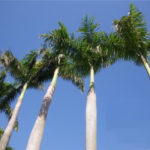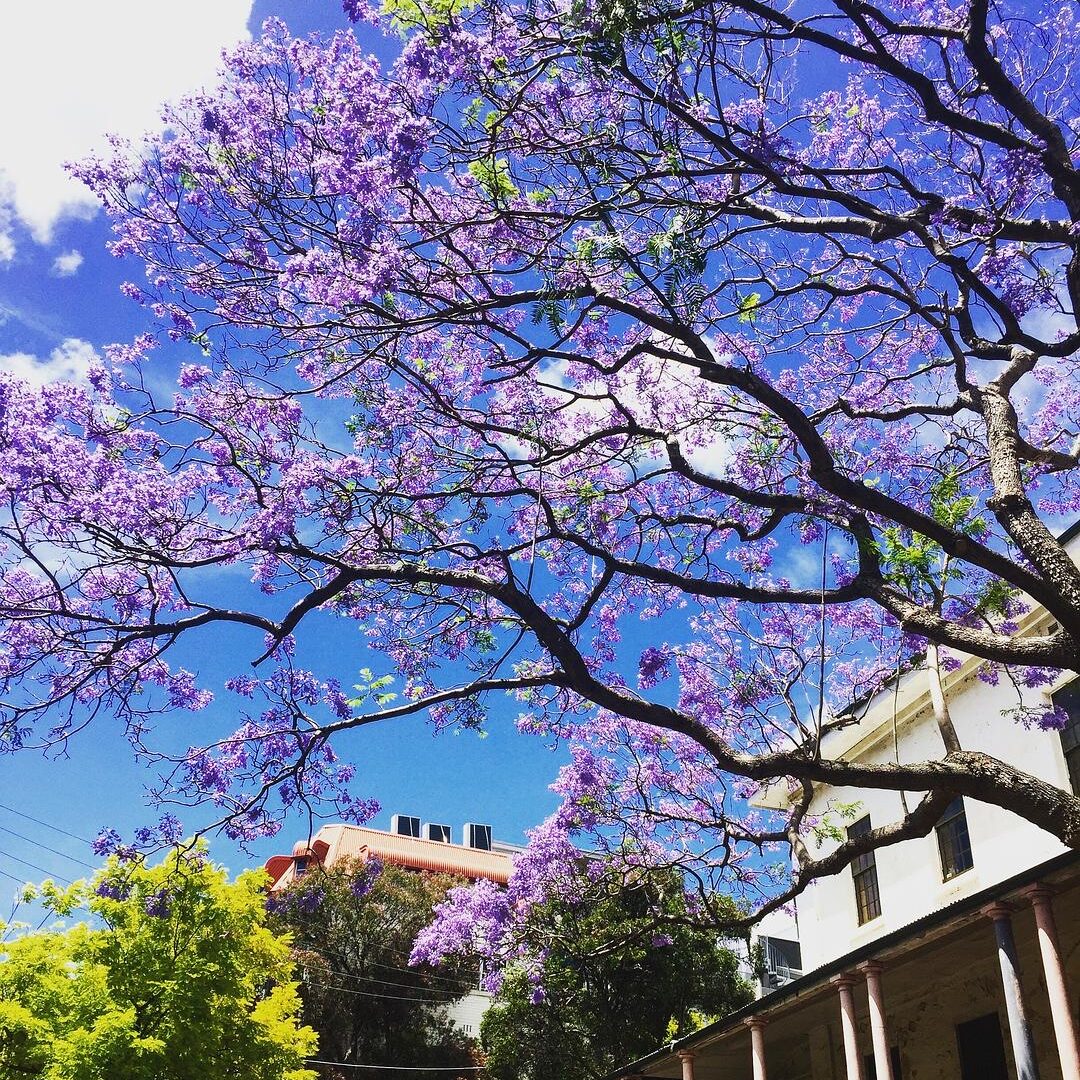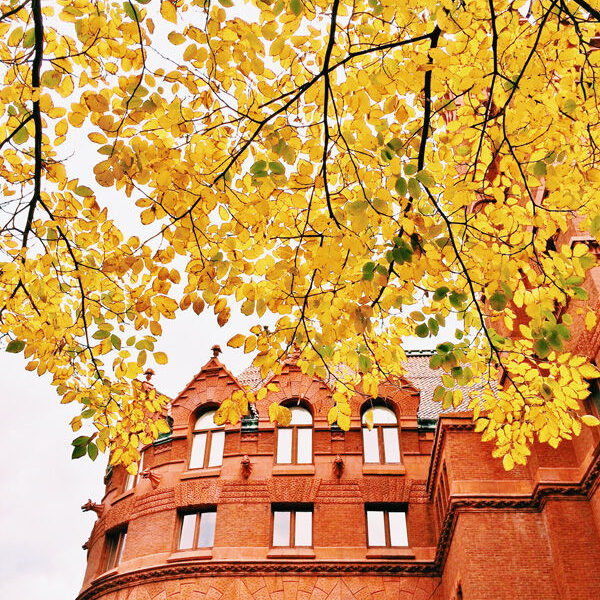Scale Model Trees:
The Ultimate Guide
Scale model trees are indispensable when it comes to scale models.
Why are scale model trees so important?
There’s a wide variety of trees in nature with shapes different from another.
What does a scale model tree usually look like? How many types are there?
What’s the making process like? This article will help you find the answers.
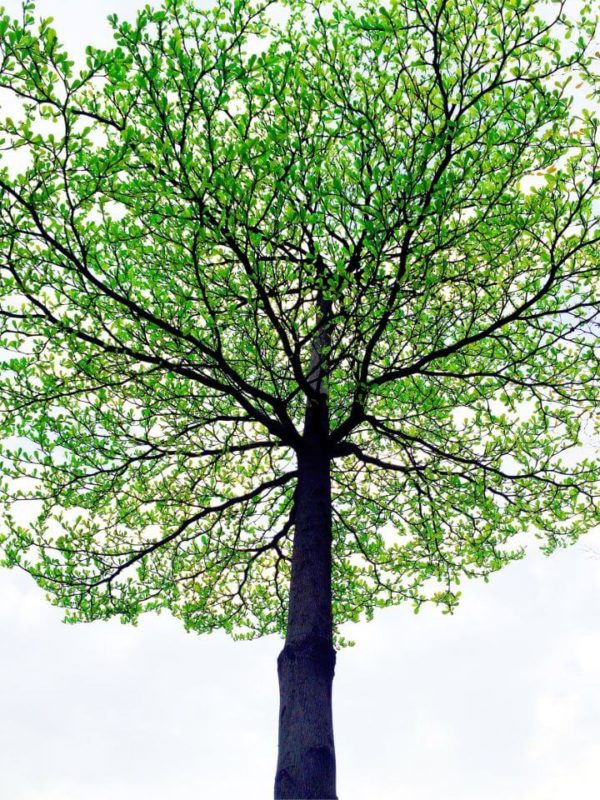
Contents
CHAPTER 1:
The Ultimate Guide
A topnotch architectural model is one that not only actualizes the designer’s vision precisely but also full of its character, in which scale model trees play a vital part.
In the eyes of a model maker, trees are irreplaceable though their roles are often secondary.
In short, the importance of scale model trees shows in these aspects:
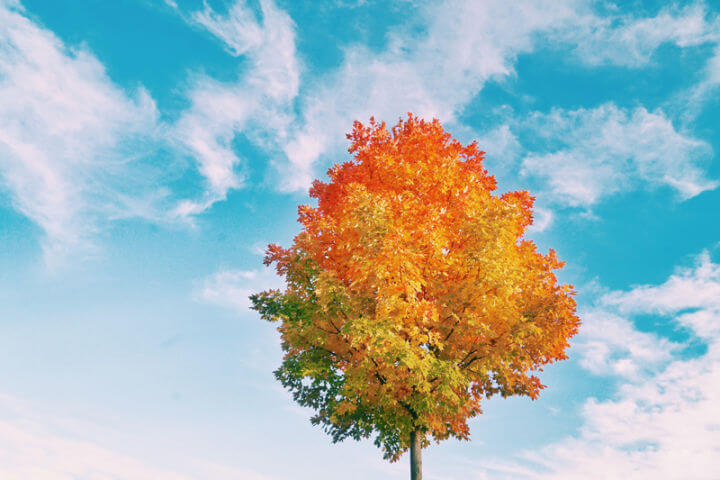
CHAPTER 1.1
Functional Value
The most fundamental role of scale model trees is to complement the main construction and express the designer's vision.
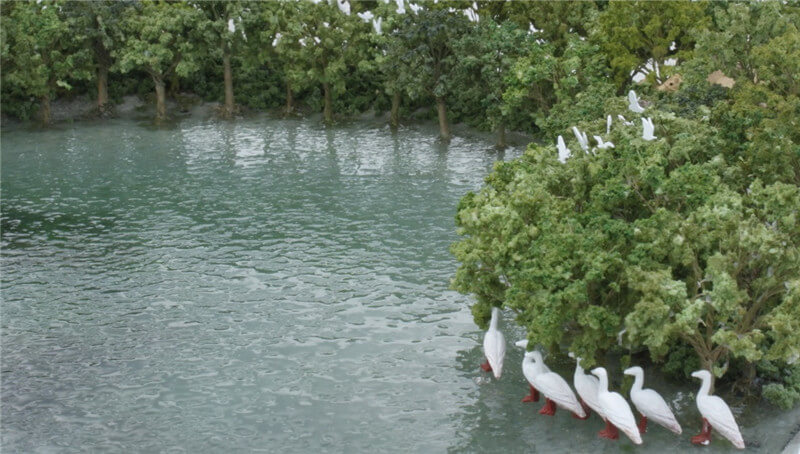
Trees are to scale models, like stars in the night sky, fish in the ocean and the dashing neon of a cityscape.
They soundlessly complement the main construction and the unique atmosphere of its surroundings.
Making the entire scale model not only livelier and more dynamic but also allowing the viewers to intuitively feel the glamour of the scenery.
CHAPTER 1.2
Space Intervals
Other than representing “trees”, scale model trees can also be used for space partition purposes.
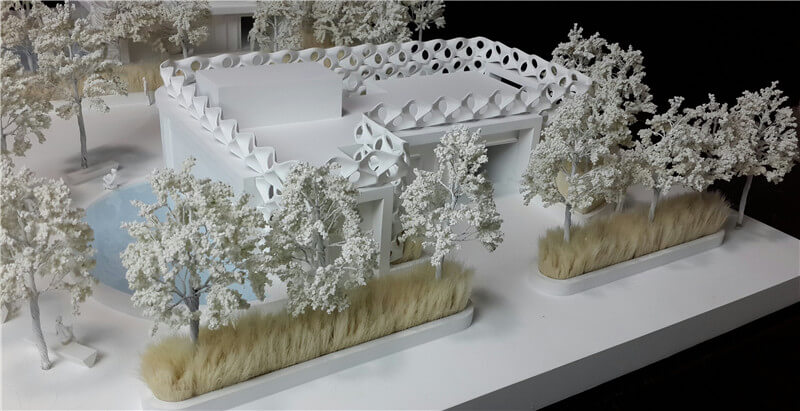
Where trees are placed in a scale model, it often demonstrates the landscaping area, the center of the space, border of the space, the precedence of each area and so on.
By using different enclosing measures, designers can use scale model trees to create open spaces, semi-open spaces, enclosed spaces, and vertical spaces, allowing the viewers to understand the spatial layout at glance.
CHAPTER 1.3
Providing References
The most influential architectural design firms and real estate developers often pay more attention to the details in scale modeling.
Architectural scale models are the best instrument for people to understand a project.
And the marketing efforts that follow will too constantly bring attention back to the scale model hence forward.
In a well-made architectural model, architectural model making trees can be seen as dimension references, showing the viewers the relevance of the architecture and its surroundings.
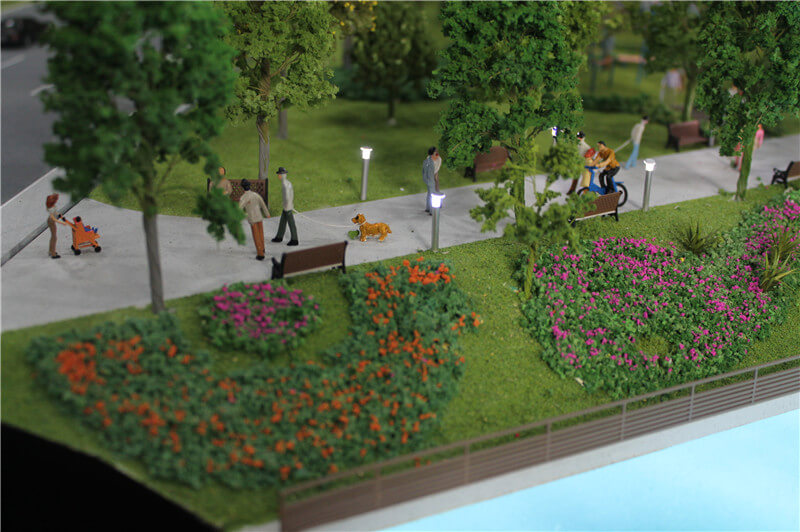
Well-thought designers can be quite particular about the size of each model tree.
They not only accord with the appearance, size, and proportion of the actual objects, but also in a different aspect, reflect the size of the main construction, its surroundings, and other objects.
Moreover, we can also learn about the distribution and size of the landscape model through the color contrast and hue variation of scale model trees.
CHAPTER 1. 4
Aesthetic Value
Without accompaniments, an architectural model will be nothing but just a normal scale model.
But with the help of scale model trees, it gains a sense of character and beauty, bringing out a full artistic vibe.
When lining up neatly, scale model trees display the beauty of order.
And when placed with a seemingly-at-random layout, they appear as organic as nature can be. Combining these two designs, one can feel the beauty of humanity and nature all at once.
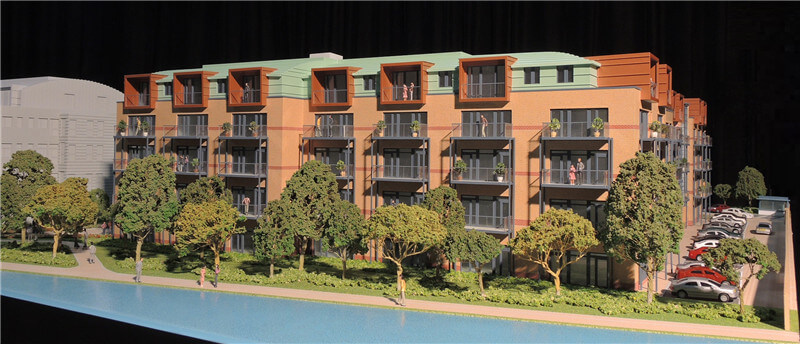
The color variation of scale model trees is also a way of artistic expression.
To be in coherence with the main construction’s volume and shape, the color scheme of scale model trees may vary in accordance.
They either make up for each other or create contrast. They need to be not only realistic but also artistic, putting the main construction in the spotlight, but at the same time complementing each other.
The varying color of scale model trees has brought more depths and dimensions. It adds a sense of rhythm to the overall effect, turning a regular scale model into art creation.
Our lives and tress have always been intertwined and correlated. Trees not only purify the air, but they also have the properties of windbreaks and sand-breaks.
They create a habitable ecological environment and provide us with flowers, fruits, seeds, wood and many more.
People feel safe and happy when there are trees around. So, it's only reasonable when people evaluate a construction project base on its landscaping standard.
If you wish to elevate the lifestyle presentation of a scale model, trees are one of the most important aspects to emphasize on.
CHAPTER 1.5
Elevating Taste
Architectural models are not just scaled-down versions of the real object.
They are also a representation of the local economy, culture, and livelihood.
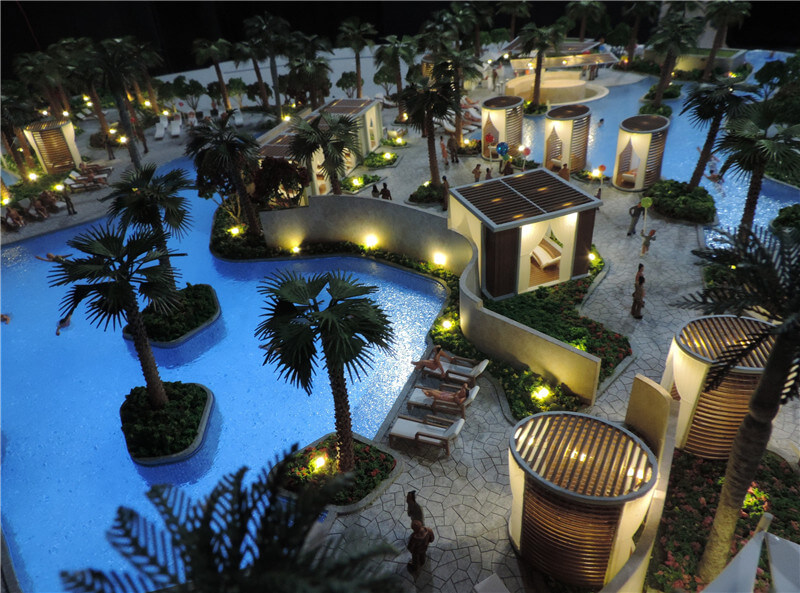
Scale model trees that weren’t well-thought-out have no meaning than just an object being placed.
In the eye of a master modeler, trees are alive.
They can be arranged in various forms and combinations to deliver a deeper message and create a distinctive atmosphere.
The viewers are presented with a sense of culture, leaving a memorable impression, just like some poem about trees.
CHAPTER 2:
Common Shape of the Scale Model Trees
Breathing life into an architectural model may involve spreading miniature trees in it.
Do you want to know how each tree shape can be distinct and fit perfectly into your specific scale models? Read on to find out.
Beyond the hard concrete and cobblestones of architectural scale models, trees can actually soften things up.
To help you select the right tree shape, here are some of the palette of tree shapes we use for our architectural model.
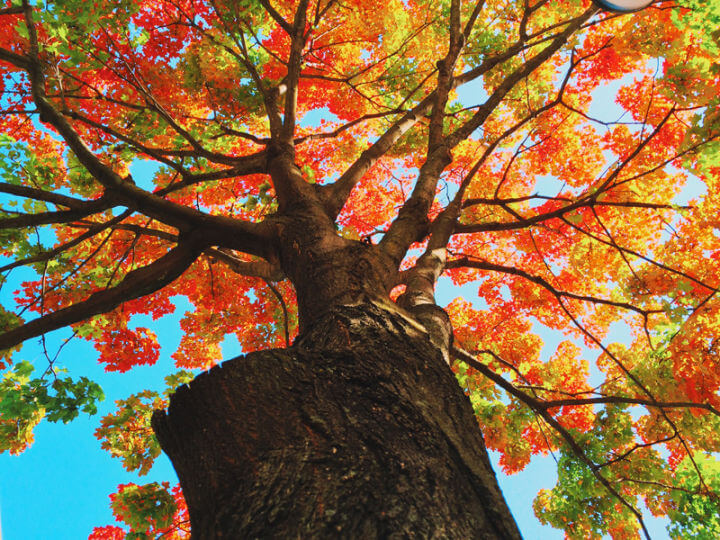
CHAPTER 2.1
Columnar Shaped Trees
Columnar trees are distinctly slender, with vertically-oriented shapes that fit perfectly in tight spaces.
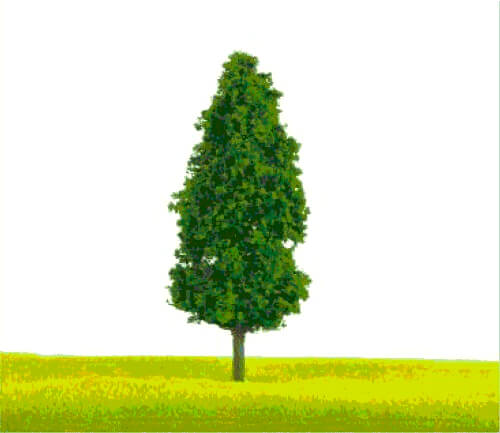
TL01 Columnar Shaped Trees
Some examples of Columnar Trees are Juniper, Maple, Italian Cypress, Lombardy poplar and Spruce.
They are mostly planted in areas where spreading tree branches aren’t suitable. Their tall figures can also compliment small structures.
What you can do best with Columnar trees is to line them up in your property lawn to distinguish boundaries. They are also great privacy hedges and noise buffers.
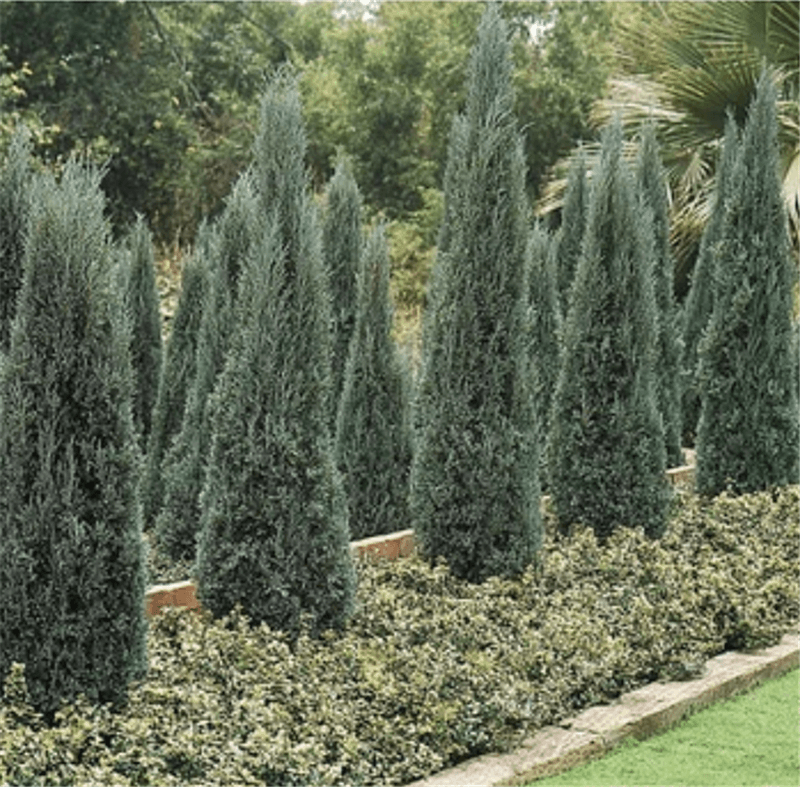
Example of Columnar Shaped Trees, Juniper (image from internet)
If you want to use Columnar Trees as individual accents, the best way is to use two to define the entrance of your door or gateway.
CHAPTER 2.3
Conical Shaped Trees
Conical-shaped trees make the best Christmas trees. As you know, Christmas trees have needle-like leaves that help them slide off the snow during winter.
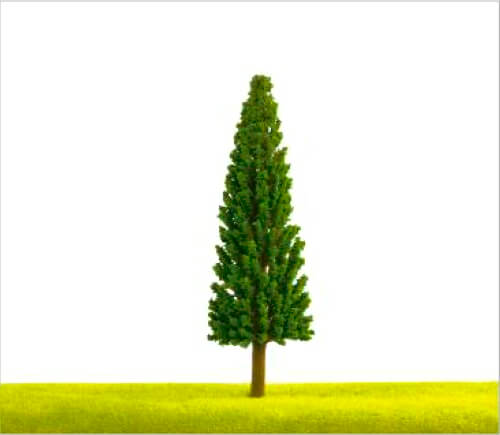
TL02 Conical Shaped Trees
They are also easy to trim and have sturdy branches that are best for holding decorations.
That’s exactly the best description of conical-shaped trees. They have a distinctive wider bottom, gradually narrowing in shape as branch patterns move up.
Some examples of Conical Trees are Pine trees, Western Red Cedar, Fraser Fir and Pin Oak.
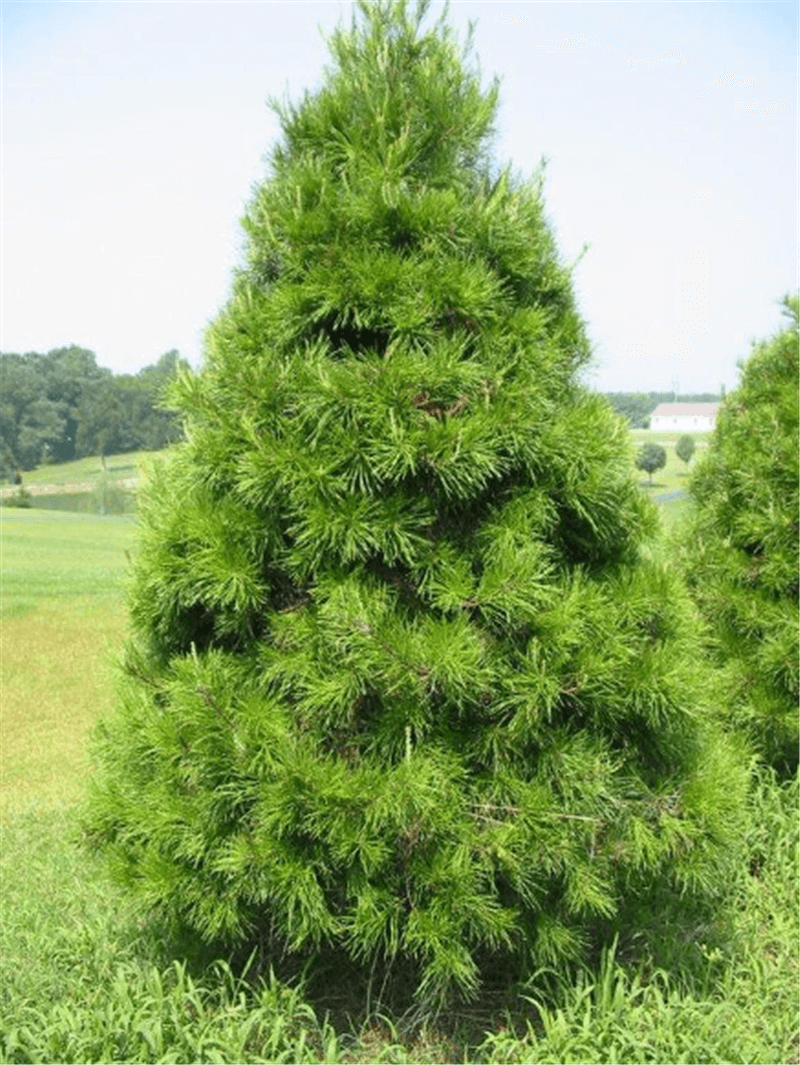
Example of Conical Shaped Trees, Pine (image from internet)
You may easily mistake them for Pyramidal-shaped trees as they both may look similar. But Conical Trees are actually thinner with a generally bullet-like shape.
CHAPTER 2.4
Oval Shaped Trees
Oval Trees have a dominant central trunk that spreads its branches into an oval-like shape.
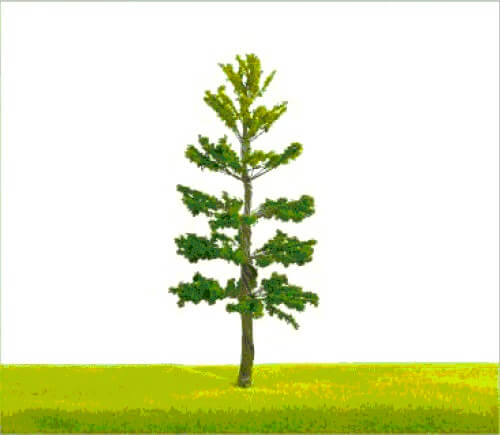
TL03 Oval Shaped Trees
Because of their thick and almost leaf-populated branches, they can render significant shading for people and small properties.
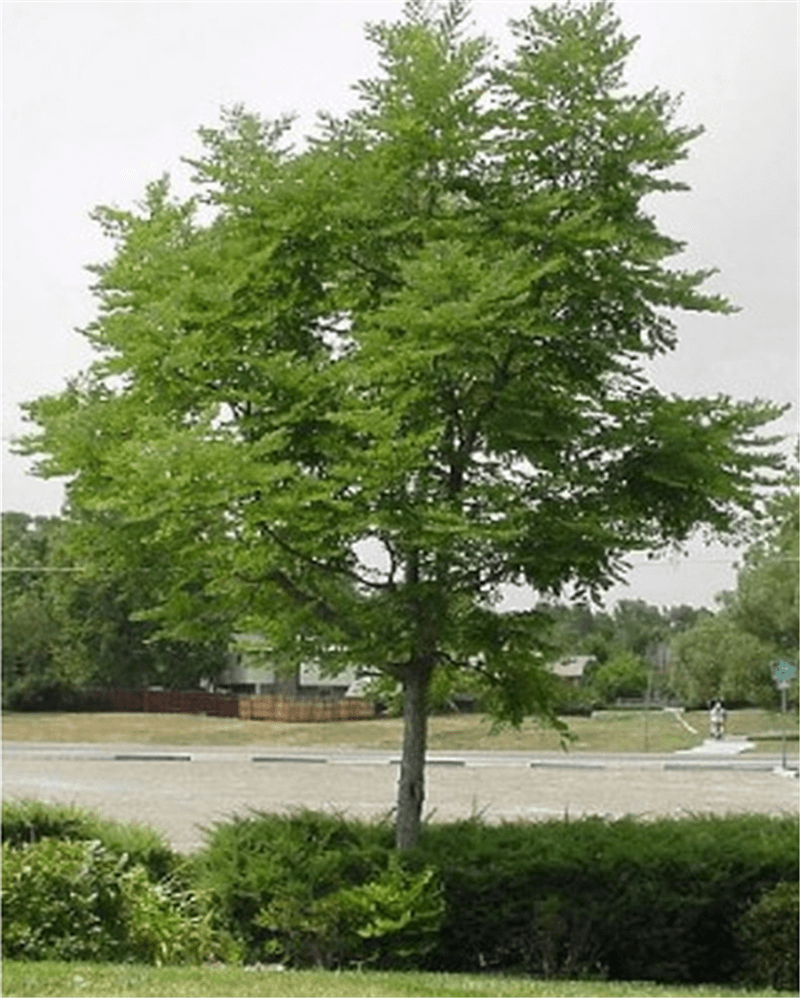
Example of Oval Shaped Trees, Kentucky Coffee (image from internet)
Examples of Oval Shaped Trees are Green Ash, Norway Maple, Kentucky Coffee tree, American Mountain Ash, Bradford Pear and Sugar Maple.
CHAPTER 2.5
Open Shaped Trees
Open-shaped trees look similar to spreading-shaped trees because of their wide profile and open arm-like branches. What’s distinct about them is that their branching appears more random and asymmetrical.
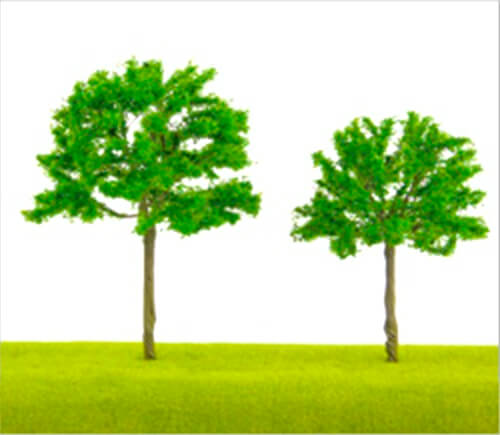
TL04 Open Shaped Trees
Examples of Open-shaped trees are ash, hickory, silver maple and catalpa.
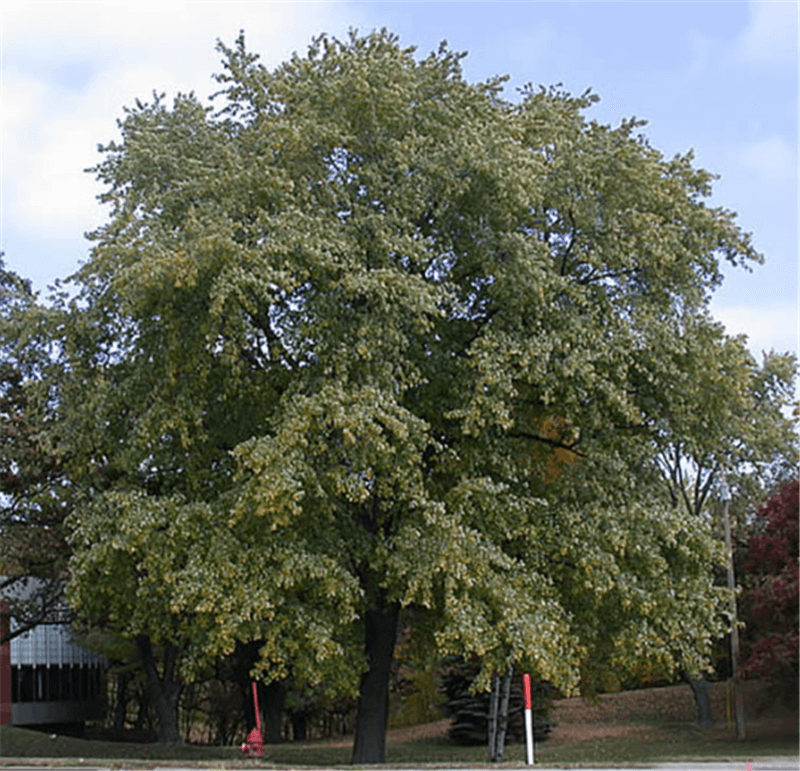
Example of Oval Shaped Trees, Silver Maple (image from internet)
Faraway, these trees may silhouette an irregular shape and emanate a dystopic feeling. But they do present an overwhelming shade for a house or slender building.
CHAPTER 2.6
Pyramidal Shaped Trees
Pyramidal shaped trees have almost the same features and shape as the Conical Trees - wider profile at the base and moving in a triangular-like shape upwards.
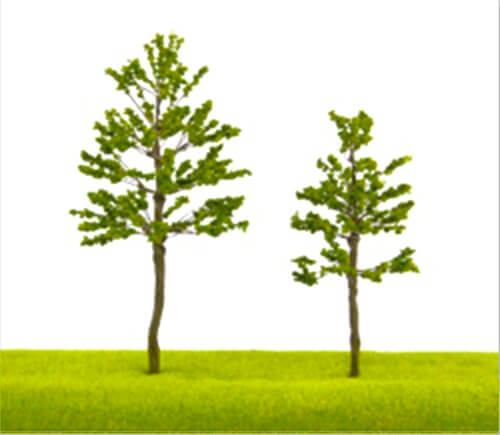
TL05 Pyramidal Shaped Trees
Unlike conical trees which have thinner profiles, Pyramidal trees may overwhelm a space with its spreading branches. Their branches may also start at the bottom of their trunks or higher up.
Some examples of Pyramidal-shaped trees are the Bald Cypress, White Fir, Ginkgo Biloba, Liquid Amber, Dawn Redwood and American Linden.
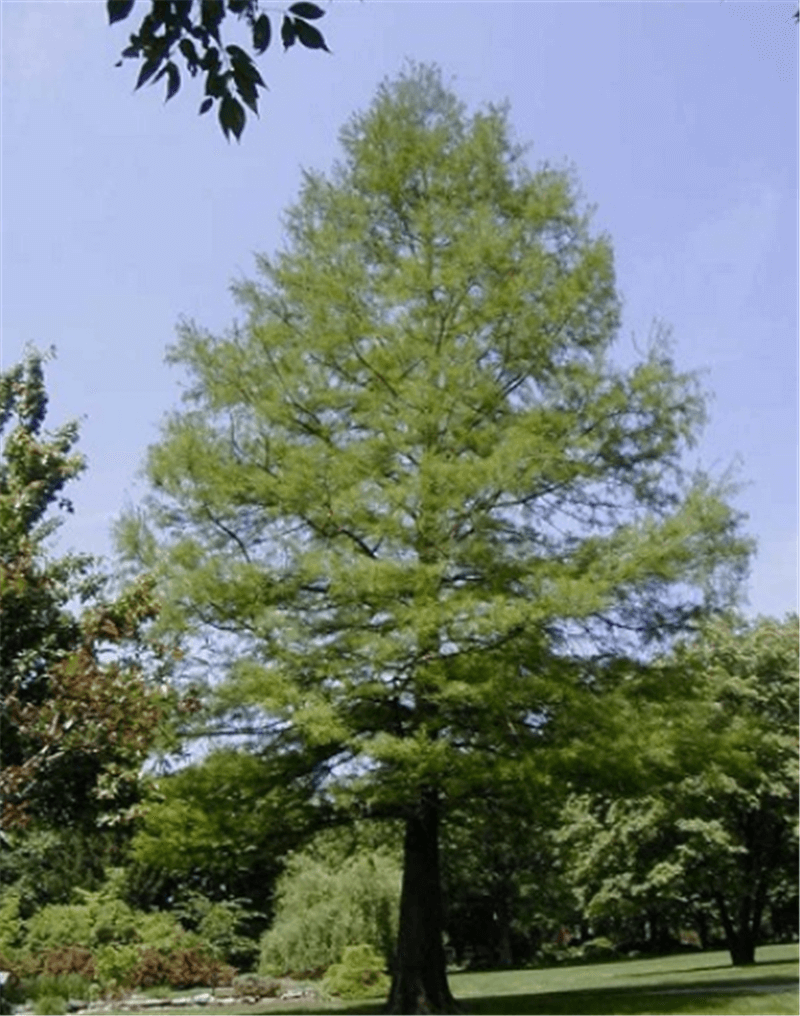
Example of Pyramidal Shaped Trees, Bald Cypress (image from internet)
Pyramidal shaped trees have more pronounced and evenly-spaced branches that communicate better organization. Hence, they also make great Christmas trees.
CHAPTER 2.7
Round Shaped Trees
Round-shaped trees collectively form sphere-like profiles. They have a cute, shrub-like canopy, emanating naturally full and compact foliage.
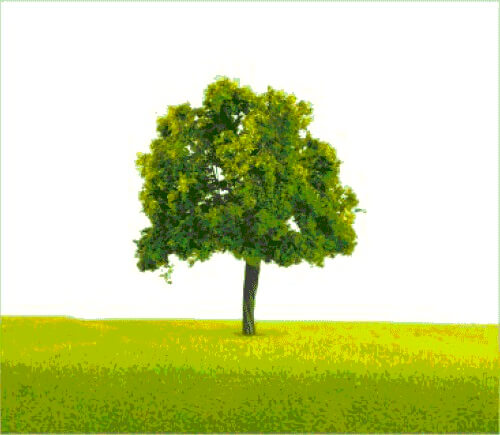
TL06 Round Shaped Trees
Round-shape trees have an upright trunk that branches out dense, globe-like crowns. They are perfect landscaping trees for small yards and gardens because of their lean and traditional image.
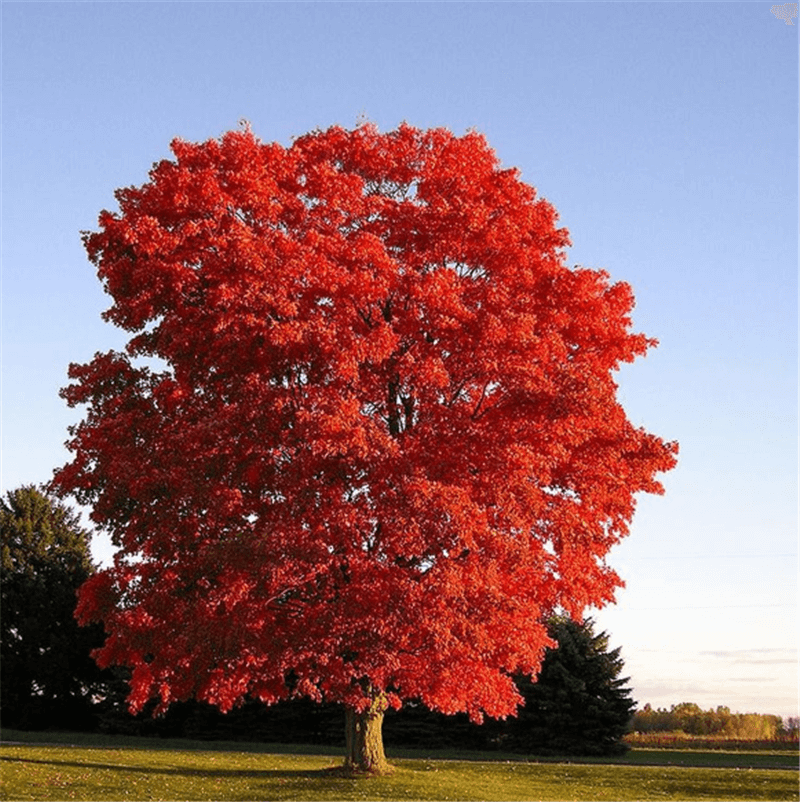
Example of Round Shaped Trees, Sugar Maple (image from internet)
Some Round-shaped tree examples are Red Oak, Jacaranda, White Ash, Globe tree, Bradford Pear, Weeping Bottlebrush, Sugar Maple and Camphor Laurel.
CHAPTER 2.8
Spreading Shaped Trees
Spreading trees can draw anyone’s attention with their wide canopies at the bottom that can often signify protection.
They may also appear massive than they are tall, making them great for filling up empty spaces and estates.
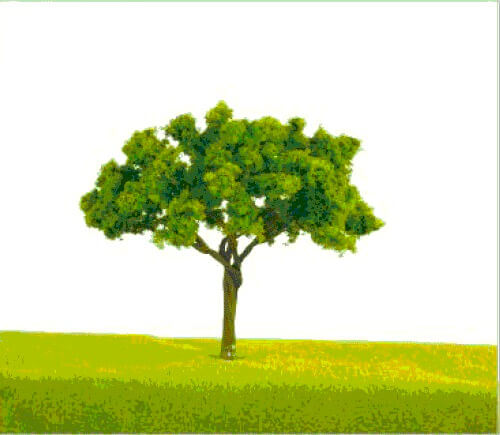
TL07 Spreading Shaped Trees
Spreading trees can also compliment narrow structures or bungalow-type houses, softening their surrounding buildings.
They are great for romantic sceneries as they have irregularly-horizontal branches that are perfect for shading anything underneath.
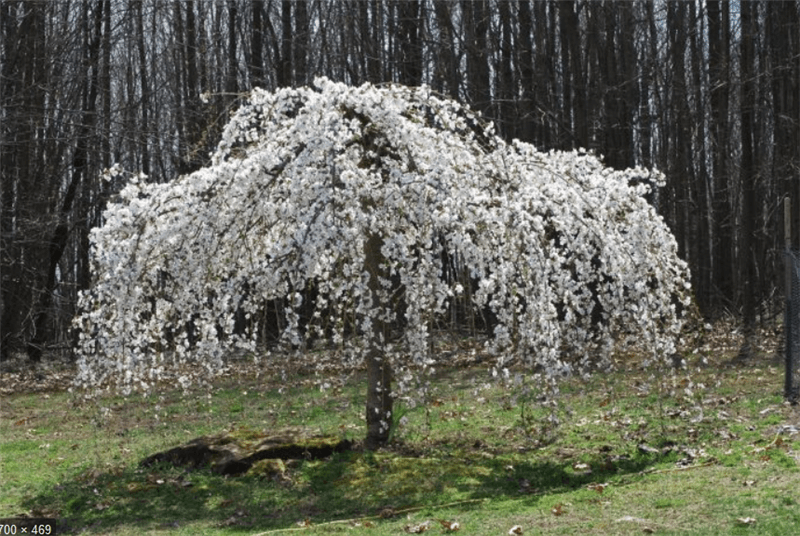
Example of Spreading Shaped Trees, Cherry tree (image from internet)
Some examples of Spreading Trees are Japanese Maple, Cherry tree, Korean Dogwood, Ginkgo, Red White Oak and Mimosa.
CHAPTER 2.9
Umbrella Shaped Trees
Umbrella-shaped trees have wide tops that also make great canopies like spreading-shaped trees. If you want a nice shade on your patio or balcony, these are the perfect types of tree to do that.
Umbrella-shaped trees have spreading branches with multiple stems that make them appear massive.
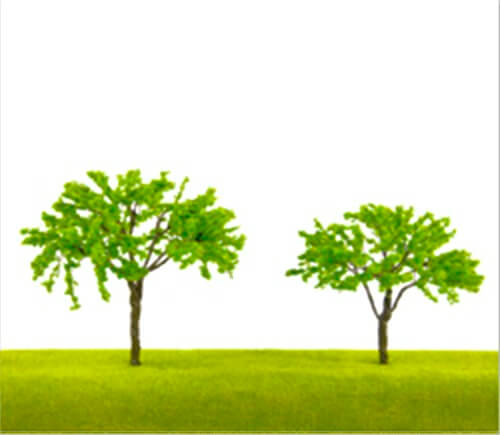
TL08 Umbrella Shaped Trees
And because of their higher branches from the ground, they can naturally provide an open view under their canopies.
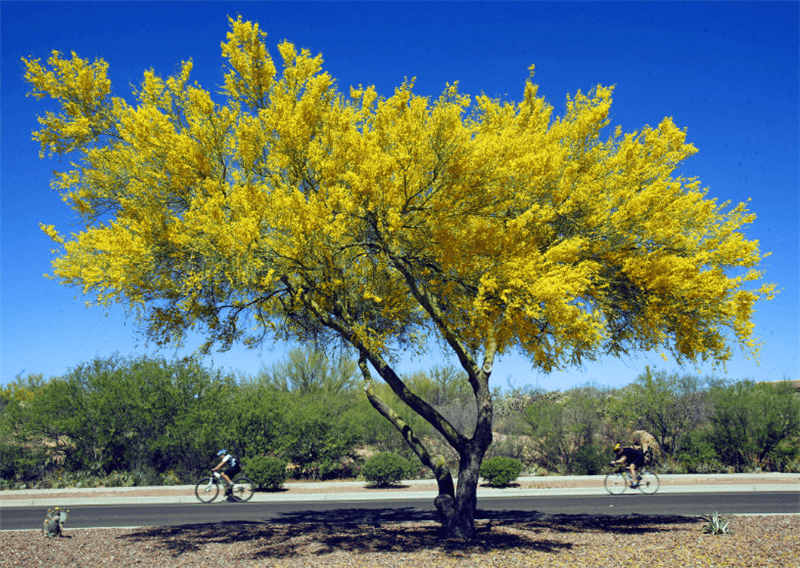
Example of Spreading Shaped Trees, Palo Verde (image from internet)
Umbrella trees may also form a flat crown at the top or a rounded form. Some examples of these tree types are the Acacia tree, Palo Verde, Silk Floss tree and Holly Oak.
CHAPTER 2.10
Vase Shaped Trees
Vase-shaped trees, as implied by its name, has a vase-like form.
In contrast with Conical-shaped trees, vase tree shapes have a slender base gradually broadening in shape as its branches goes up.
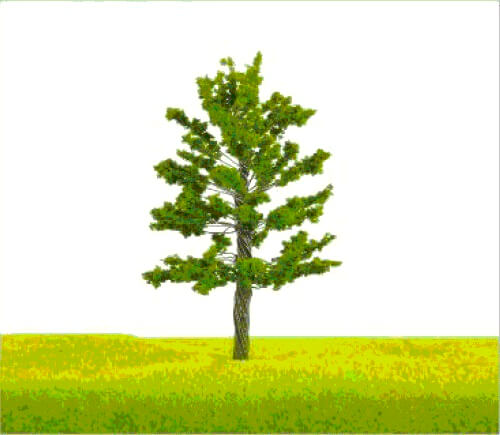
TL09 Vase Shaped Trees
As they are narrow underneath and do not block people’s views, they great for lining up roadways.
And as they have wide tops, they are perfect as pathway canopies, providing significant shades. They are also the best choice for forming gothic tree arches to line streets.

Example of Vase Shaped Trees, American Elm (image from internet)
Examples are the American Elm, Goldenrain tree, Amur maple, Japanese Zelkova, Kwanzan Cherry and many more.
CHAPTER 2.10
Conclusion
Different tree shapes, sizes and colors can amplify the direct purpose of your modeling scenario.
Trees have stood as artistic mimicries of what nature can add up to your specific landscape in mind.
Whether you want to cast a scenic woodland, a dense forest or pave the streets of Sakai with green canopies, use a couple of tree models to add remarkable realism.
Trees, as they are in co-existence with human society, have painted and molded the world with their varying shapes and sizes.
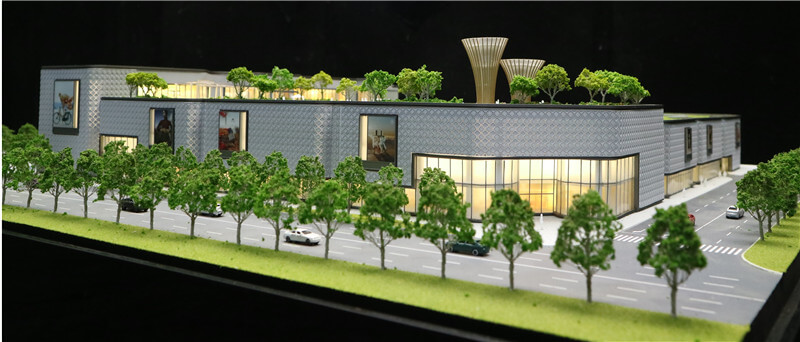
In scale models, they are fundamentally instrumental in greening the structures as well.
We hope this article has turned creative knobs in your head on what tree shapes best fit which scenarios.
If you want to opt for professionally-looking trees for your building structures, we have adopted several cutting-edge modeling technologies in our company.
TL Models can handcraft the best realistic fauna and flora landscape for building structures that can truly exude the wondrous combination of concrete buildings and nature.
What's more, we offer site installations and provide debugging services, along with our great customer service provision for your convenience.
CHAPTER 3:
Examples of Common Scale Model Trees
From Stanley Park in Canada to the Tokyo streets covered in cherry blossom, trees have become an indispensable part of human lives.
They've not only embellished our cities, but they’ve also brought many benefits to the environment.
The same rule also applies to scale models. Many scale model trees are not designed only for decorative purposes.
Different shades of green leaves not only make the architectural model more appealing to look at, but it also brings liveliness to the scene, creating a cheerful living atmosphere.
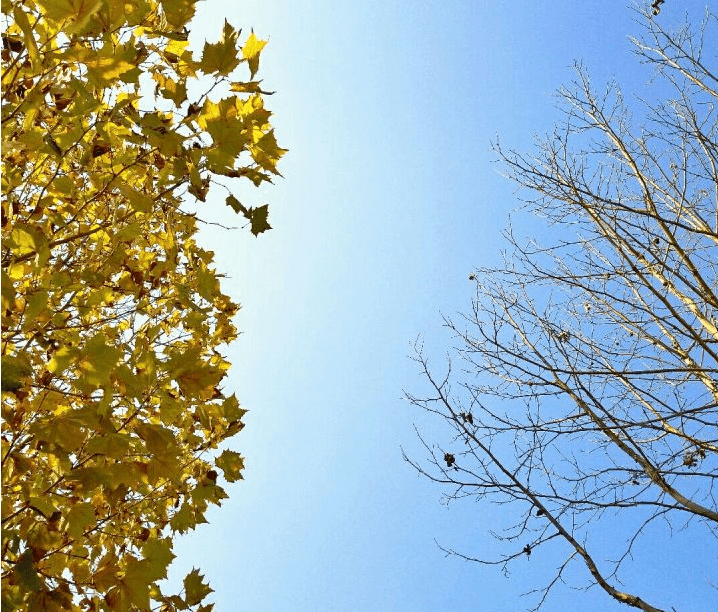
CHAPTER 3.1
Ginkgo biloba L
Ginkgo Biloba L is the only living species in the division Ginkgophyta.
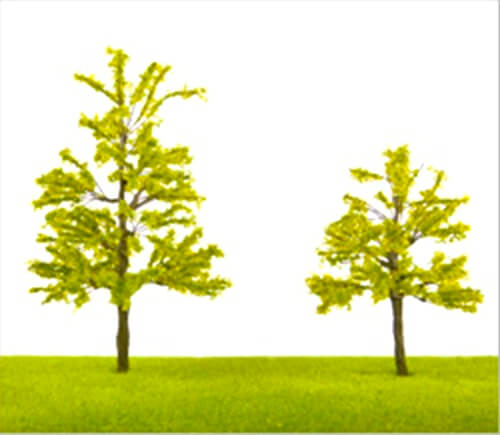
Scale model tree of Ginkgo Biloba
All other ginkgo species are extinct with only fossils found dating back 2000 million years.
The fruit and leaves of Ginkgo Biloba L can be used as a source of food and has valuable medicinal properties.
As a deciduous tree, Ginkgo Biloba L is famous for its graceful figure and unique fan-shaped leaves which carry a great resemblance to maidenhair ferns. This is also why they are commonly called “maidenhair trees”.
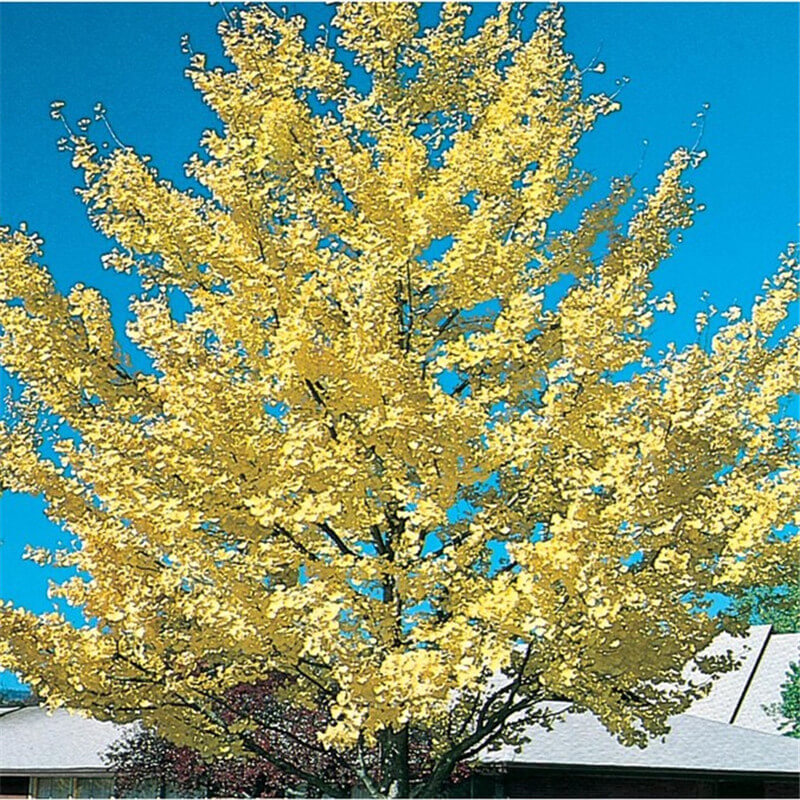
Image of Ginkgo Biloba L (image from internet)
Ginkgo biloba blooms in April and ripens in October. The leaves display a light tone of green in the summer and turn gold when autumn comes.
Due to its delicate silhouette and esthetically pleasing image, ginkgo has been widely used in gardens and allées.
In many gardens in North Korean, Japan, Europe and America, hundreds or even thousands of years old cultivated ginkgo trees have been found.
CHAPTER 3.2
Chamaecyparis nootkatensis
Cupressus nootkatensis is a species of trees commonly seen in the coastal forest regions of northwestern North America. Some of the living ones we can find today can date back thousands of years.
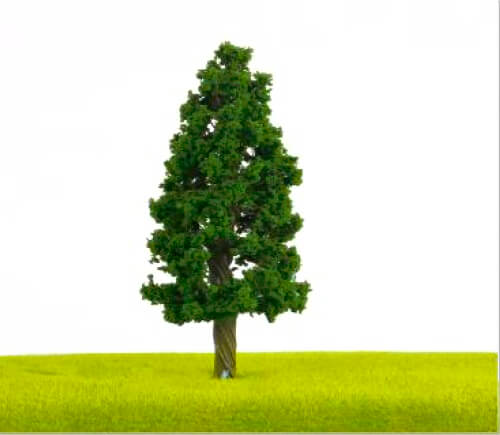
Scale model tree of Chamaecyparis nootkatensis
Their foliage display a flat spraying pattern. And because of the typically humid primitive environments, they often produce as very durable logs.
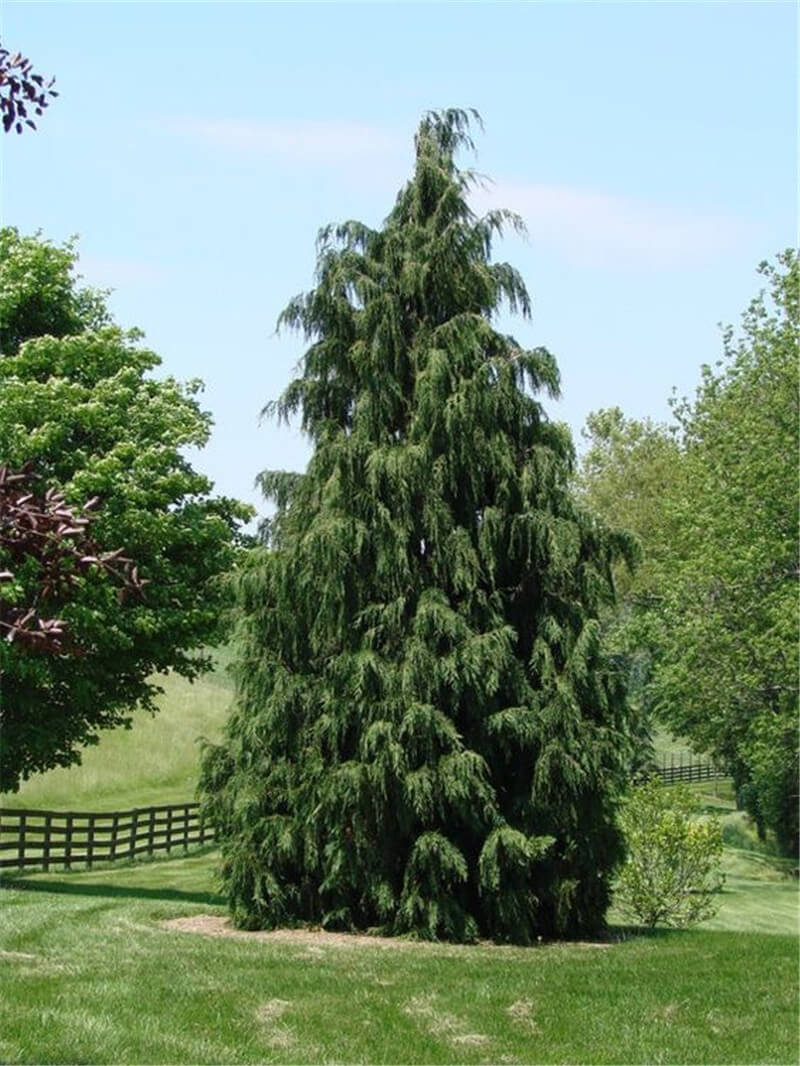
Chamaecyparis nootkatensis (image from internet)
Cupressus nootkatensis has a unique cone-shape silhouette with flexible branches. The drooping branchlets also give the tree a graceful weeping appearance.
CHAPTER 3.3
Cupressus cashmeriana Royle ex Carrière
The origin of cupressus cashmeriana currently remains unknown. In the cold regions of the northern hemisphere, they are widely grown in greenhouses as ornamental trees.

Scale model tree of Cupressus cashmeriana Royle ex Carrière
Cultivated cupressus cashmeriana trees are roughly 20 meters tall with striking figures.
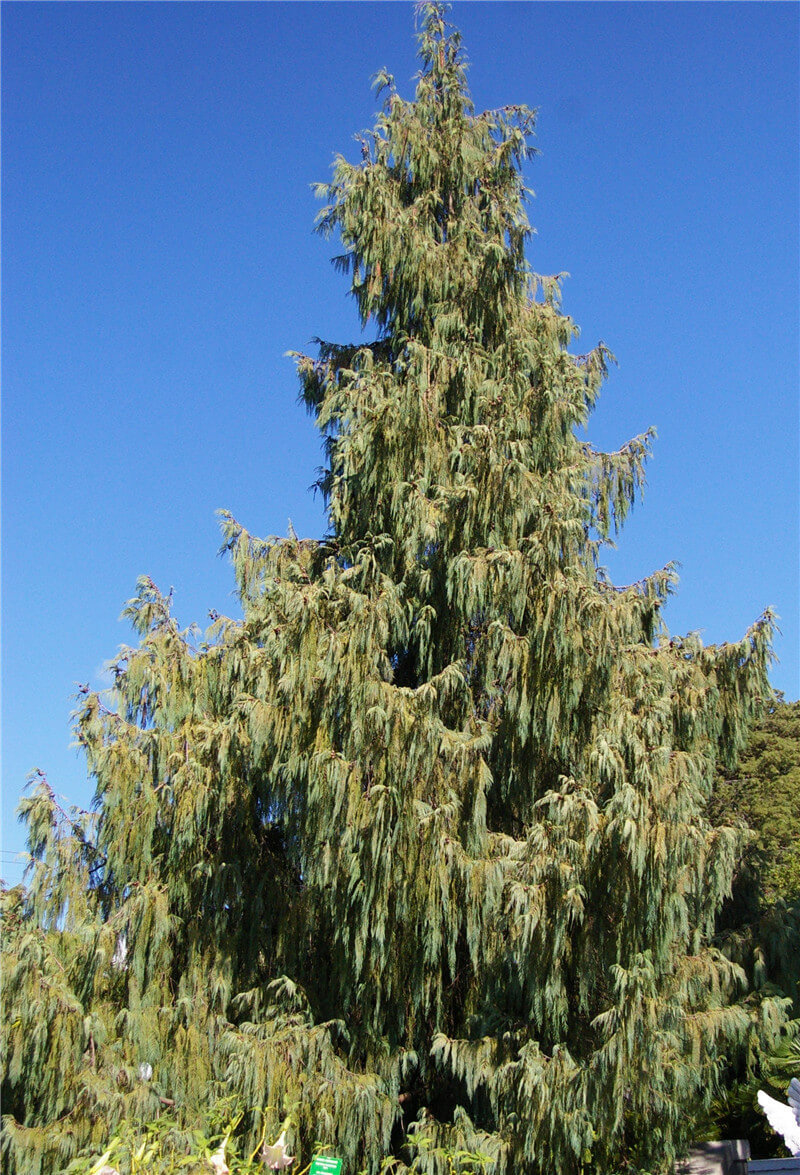
Chamaecyparis nootkatensis (image from internet)
The branches are usually pointing up with foliage grows in pendulous sprays of blue-green, forming a voluminous weeping silhouette.
CHAPTER 3.4
Taxodium distichum
Taxodium distichum is a deciduous conifer in the family Cupressaceae. It is native to the southeastern United States with the tallest being up to 25 or 30 meters.
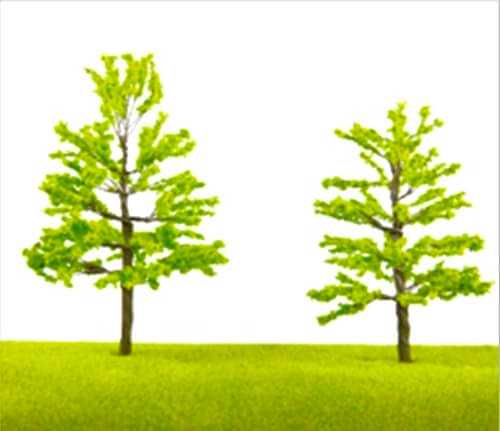
Scale model tree of Taxodium distichum
Their late falling in the autumn, with its feathery foliage and crown-shaped aesthetic, has made them a great species for gardens and urban greening.
Taxodium distichum is native to humid climates. Their roots can stay in water for months.
In autumn, the yellow leaves turn copper red, making Taxodium distichum a beautiful ornamental tree.

Taxodium distichum (image from internet)
They have been widely introduced and cultivated around the world.
Many cities in China like Guangzhou, Hangzhou, Shanghai, Nanjing, Wuhan, and Fujian have also been cultivating them.
They are usually planted in flatland areas, lakeside, riverside and water network areas.
CHAPTER 3.5
Pinus wallichiana A. B. Jackson
Pinus wallichiana has very gracefully shaped crowns forming an overall alluring silhouette. It’s charmingly colorful and full of energy.
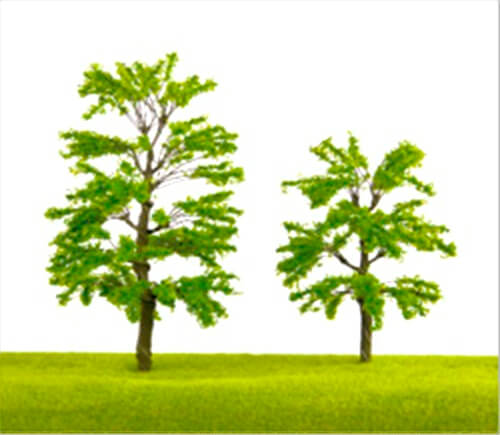
Scale model tree of Pinus wallichiana A. B. Jackson
The tree trunk is tall and straight, producing high-quality wood with fine details and texture.
They are also soft and light in weight, making it a great material for architecture, tools, and crossties. Turpentine can be extracted from it too.
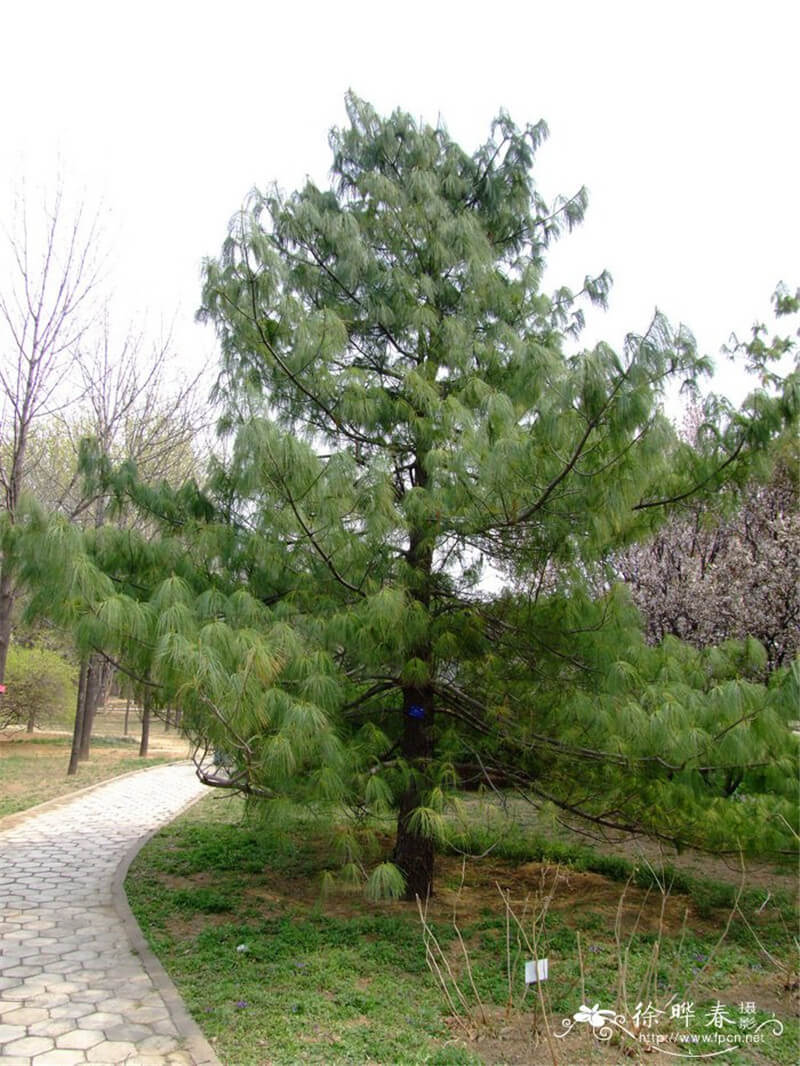
Pinus wallichiana A. B. Jackson (image from internet)
Many of the worldly renowned pine trees are originated from Asia, especially in China, Japan, and the Himalayas.
CHAPTER 3.6
California bay
California bay belongs to the family Lauraceae and has more than 40 categories with over 2000 species.
Most of them are tropical plants that are native to Asia and South America.

Scale model tree of California bay
California bay is strong and resilient. They can grow up to 30 meters tall in humid preserved valley areas.
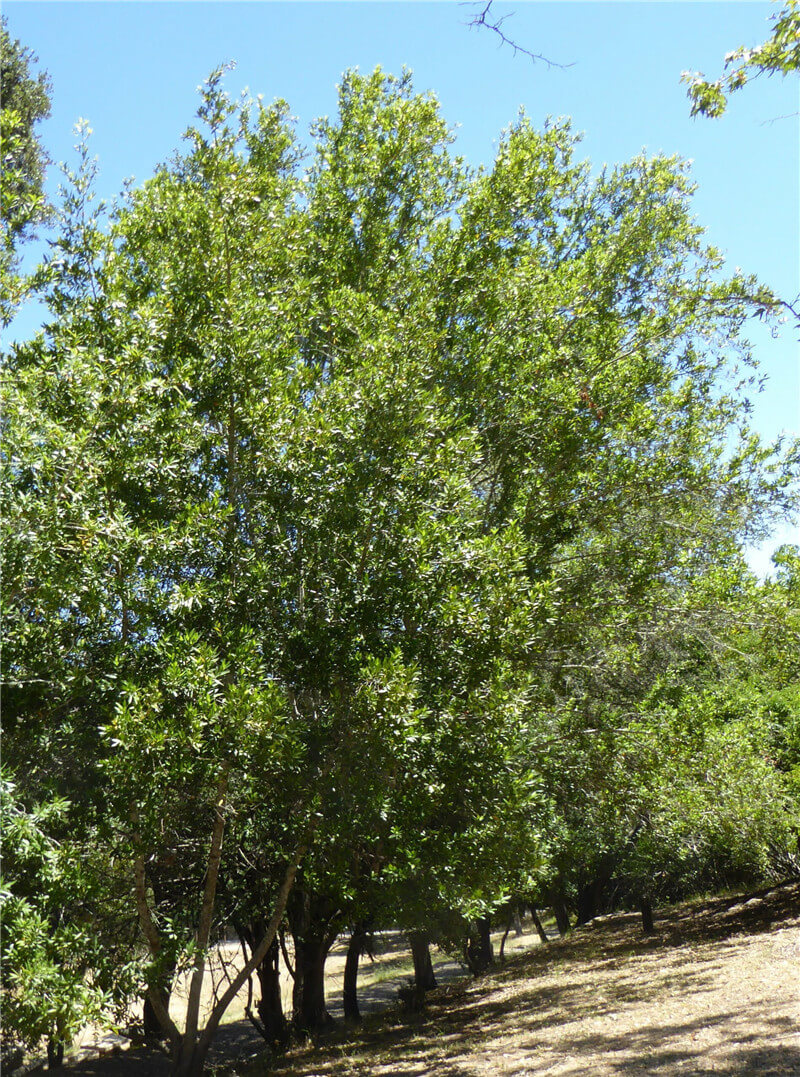
California bay (image from internet)
Lauraceae trees which endure even the most hostile environments, share many things in common: they’re evergreen and carry pungent leaves and skins.
CHAPTER 3.7
Populus lasiocarpa Oliv.
Populus lasiocarpa is a handsome medium-sized tree with the biggest, heart-shaped thick leaves in the populus family.
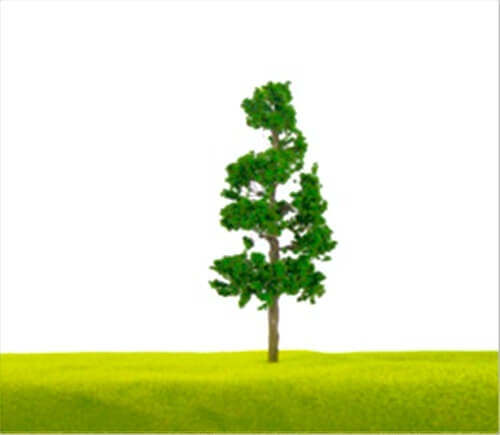
Scale model tree of Populus lasiocarpa Oliv.
They usually bloom from April to May with the fruits ripening from May to June.
Populus trees grow very fast. They may reach a height of over 20 meters. Most of them can tolerate air pollution and wet, salty sea wind.
They have an open and fluffy overall silhouette. In the winter the shoots may appear angular and jumbled.
In autumn, the leaves turn to a pale yellow and start to get crispy. When the wind blows, you can hear it passing through the trees with rustling leaves.
The wood is light and soft, great for making furniture, instruments, boards, and matchsticks.
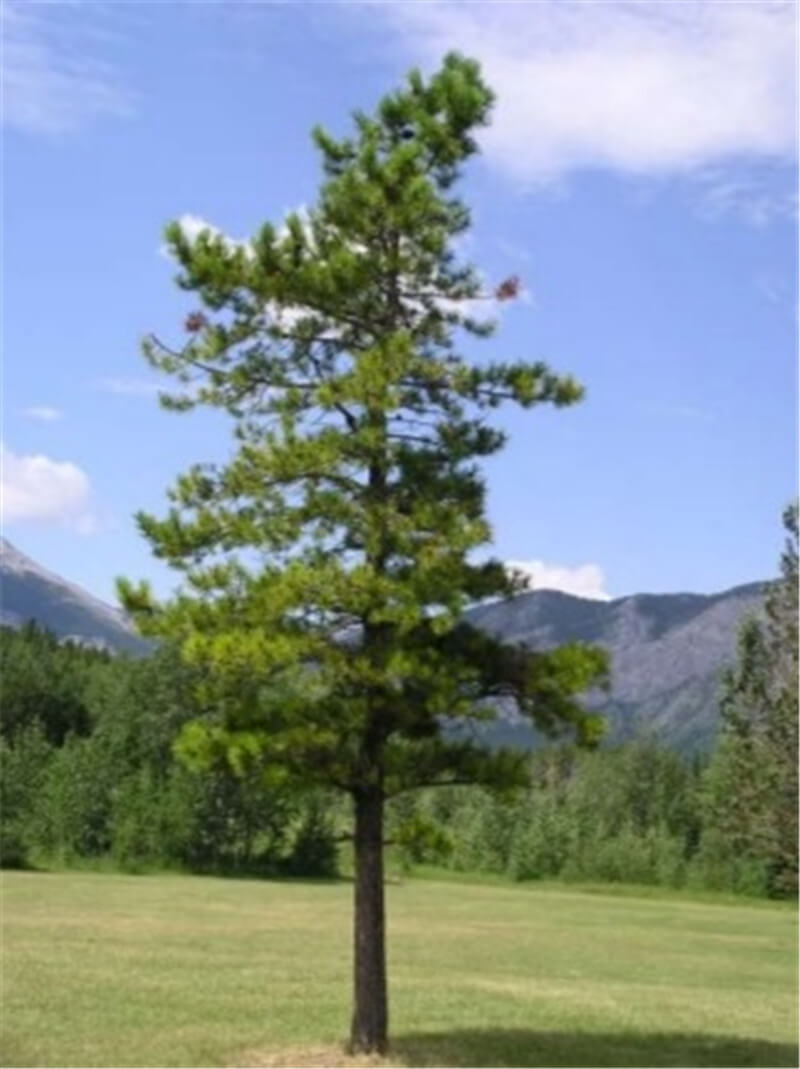
Populus lasiocarpa Oliv. (image from internet)
Its clean and white wood fiber has also made it a perfect material for papermaking.
And because of their rapid growth, they’ve become the most promising species to be planted in high-altitude wetland areas.
CHAPTER 3.8
Prunus sargentii
Prunus sargentii is a species in the genus Prunus from Rosaceae family that is native to Hokkaido Japan but can also be found in Korea and Russia.
It is suitable to be cultivated in cold regions and has high ornamental properties.

Scale model tree of Prunus sargentii
Prunus sargentii is one of the most beautiful cherry trees. It blooms in spring with abundant pink flowers, creating a stunning contrast with the sporing copper-color new leaves.
And when autumn comes, fallen leaves of reddish-orange forms yet another fascinating splendor.
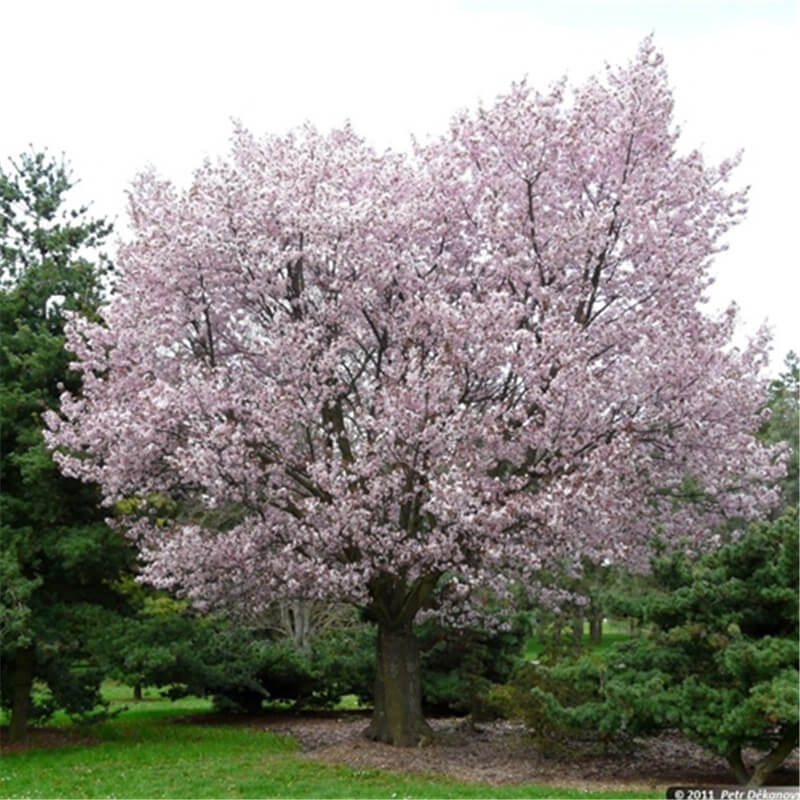
Prunus sargentii (image from internet)
Cherry trees are in the genus Prunus with more than 400 different species.
Most of them are deciduous trees native to temperate regions in the northern hemisphere.
Cherry trees, along with other charming spring-flowering trees, have been widely cultivated in parks, gardens and botanical gardens for centuries.
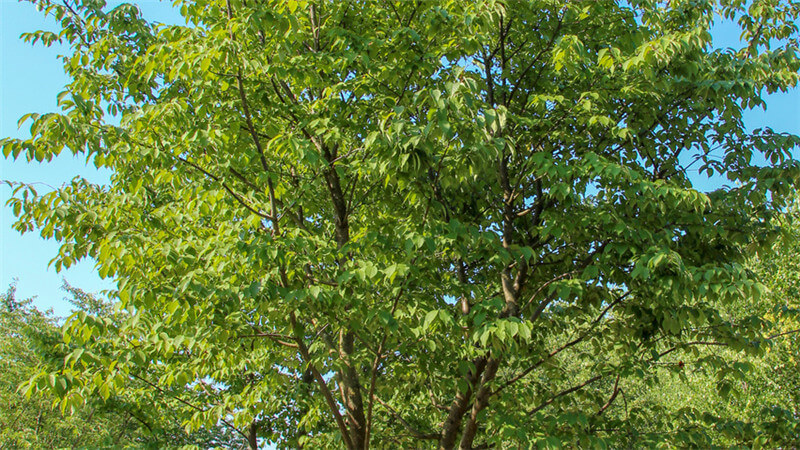
Prunus sargentii (image from internet)
Prunus sargentiihas striking visuals. Their flowers are abundant and vibrant.
The leaves turn into gorgeous orange and red in the autumn. As a topnotch Cerasus, they’ve become one of the finest ornamental trees.
CHAPTER 3.9
Malus hupehensis(Pampanin) Rehder
Malus hupehensis is one of 25 species in theapple genus Malus native to temperate regions in the northern hemisphere.
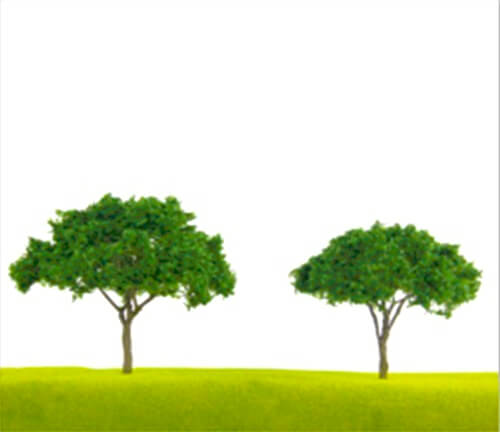
Scale model trees of Malus hupehensis (Pampanin) Rehder
Trees ofgenus Malus are often sturdy medium-sized deciduous trees. They bloom in spring with beautiful flowers and ripen at the end of summer.
Thus, became widely cultivated as ornamental trees in gardens.
Malus hupehensis is a small-sized arbor treein the apple genus Malus.
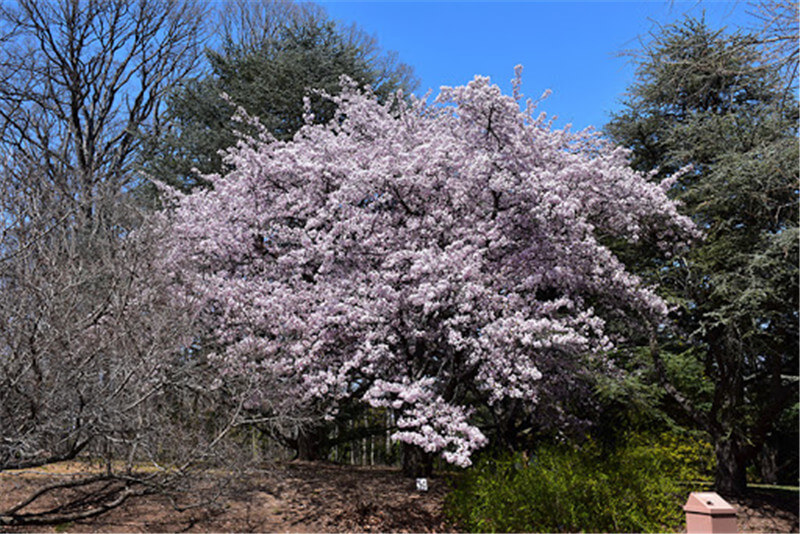
Malus hupehensis(Pampanin) Rehder (image from internet)
Its dry skin, braches, new shoots, young leaves, petiole, and some other parts display a shade of purple-brown.
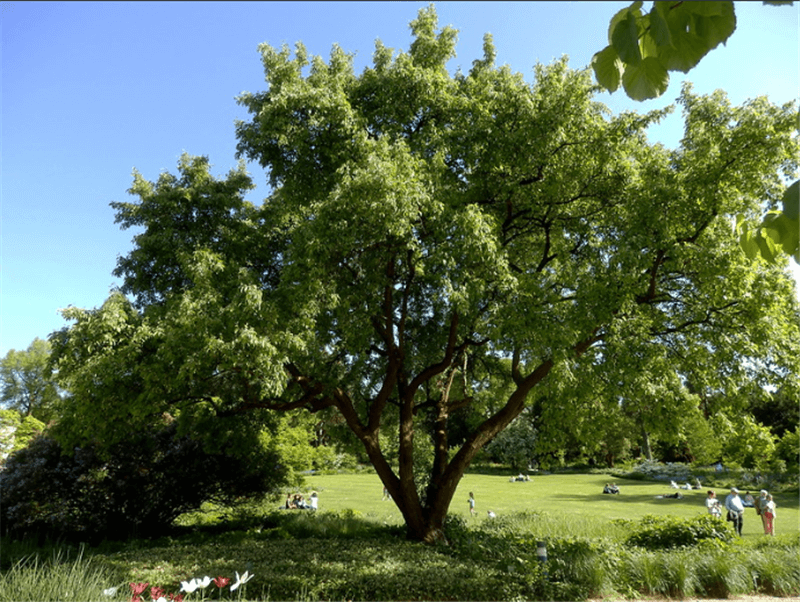
Malus hupehensis(Pampanin) Rehder (image from internet)
The flower buds are often pink and turn into a paler tone after blossoms twice a year in spring and autumn.
The fruits are red and small-sized. The trees may grow up to 8 to 12 meters making it a fine greening ornamental tree.
CHAPTER 3.10
Conclusion
Without trees, the cities are nothing but a concrete jungle.
Scale model trees have brought so much nature to the model, adding a splash of color and liveliness, creating wonderful shapes and texture.
CHAPTER 4:
Examples of Common Palm Trees
Palm trees are a botanical family in the monocot order Arecales. There are about 220 genera of palm trees mostly native to tropical, subtropical areas.
They are widely grown in nature or cultivated by man in areas centering Tropical America and Tropical Asia.
Most palm plants have solid stems. And amongst them Coconut tree, Pinang tree and palm trees are known to have high commercial value.
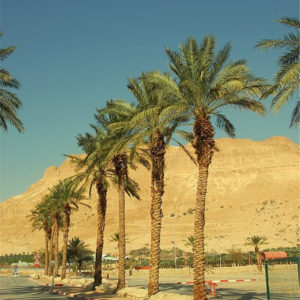
CHAPTER 4.1
Cocos nucifera
The coconut tree is an evergreen tree with a height reaching up to 30 meters. It grows on beaches and endures windy and rainy environments.

Scale model trees of Cocos nucifera
It has a slender and curvy trunk with a broader bottom. The origin of coconut trees currently remains unknown however, it’s been cultivated since prehistoric times.
All parts of a coconut tree have valuable properties and can be used for various purposes. Its leaves can be used to cover buildings, the fruits can be eaten, and the juice tastes refreshing and sweet, can be consumed unprocessed, serving as a great summer delight.
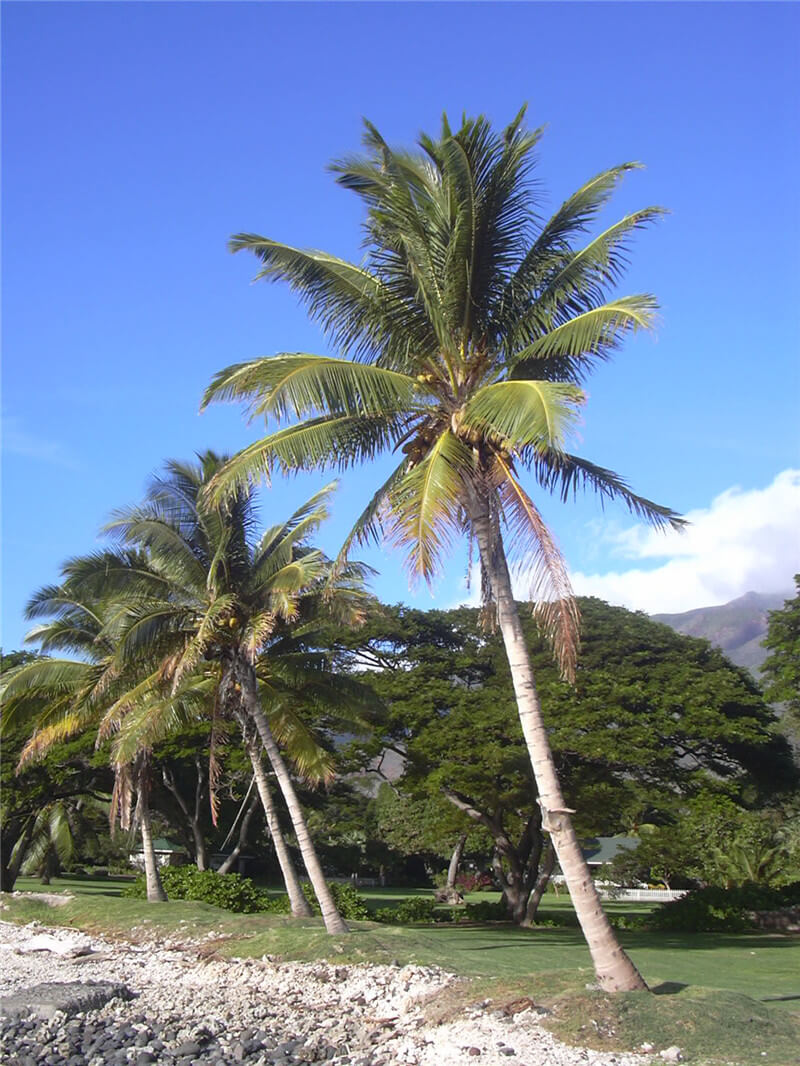
Cocos nucifera(image from internet)
According to reports, more people die annually from falling coconuts (approx. 150 people) than from shark attacks (approx. 10 people). However, the reliability of these statistics remains to be further proven.
CHAPTER 4.2
Oil Palm (Elaeis guineenis Jacq.)
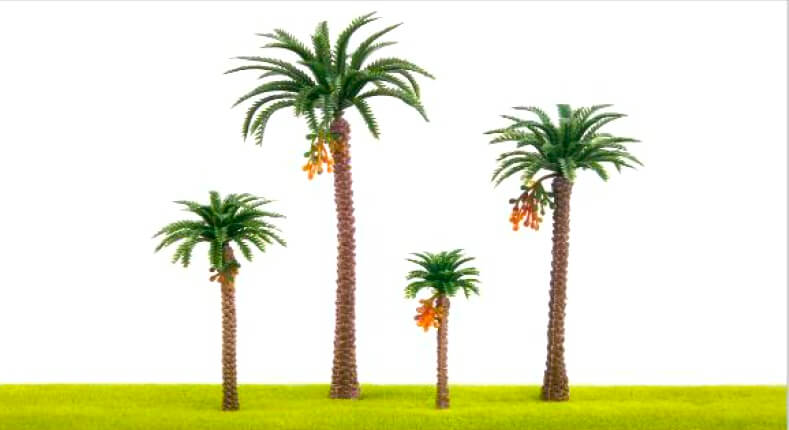
Scale model trees of Cocos nucifera
Elaeis guineensis, commonly called oil palm, is a type of palm tree from Genus Elaeis. It can grow up to 20 meters tall.
It has a broad and tough trunk with a bushy crown and drooping leaves.
It is native to West-Africa, specifically the area between Angola and the Gambia. It was later introduced to countries like Malaysia and Indonesia. It is a commercial plant mainly used for producing palm oil.
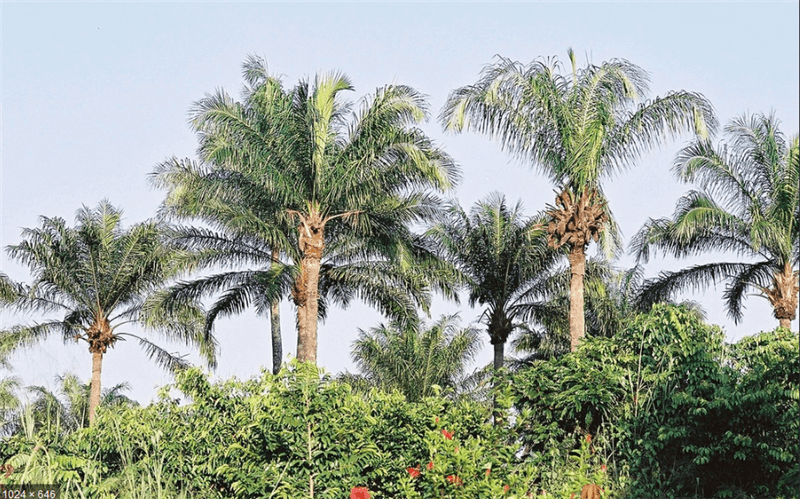
Cocos nucifera(image from internet)
CHAPTER 4.3
Bottle Palm (Hyophorbe lagenicaulis)
Hyophorbe lagenicaulis, commonly known as Bottle palm, is a type of palm tree in the genus Hyophorbe.
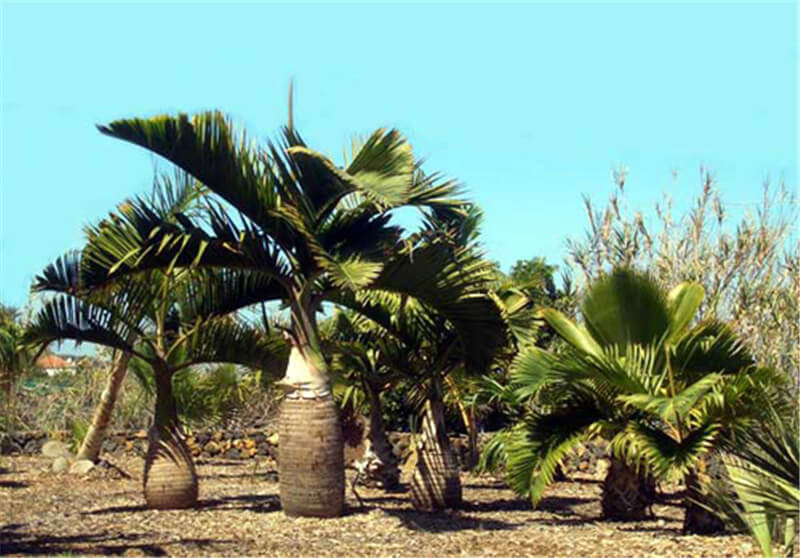
Scale model trees of Bottle Palm (Hyophorbe lagenicaulis)
It used to be naturally endemic to Round Island in Mauritius, slowly growing on local fertile volcanic soils.

Bottle Palm (Hyophorbe lagenicaulis)(image from internet)
With only a few local species remaining, however, due to the affection for its unique bottled-shape, they’re being cultivated in tropical gardens and parks in subtropical areas.
CHAPTER 4.4
Florida Royal Palm (Roystonea regia)
Florida royal palm trees grow very fast. Their straight trunks and feathery leaves make them perfect ornamental trees.
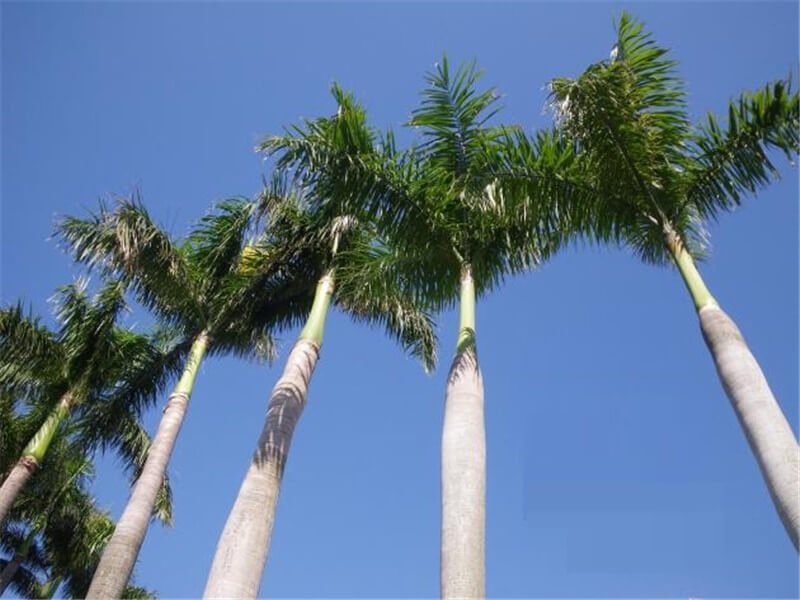
Scale model trees of Florida Royal Palm (Roystonea regia)
In tropical and subtropical areas, they are one of the most important trees in garden and landscape design.
The trunk is stout and smooth, showing a light-grey or white color with circular texture.
It has a branchless trunk in a typical palm shape.
Their graceful figure, bulky trunk, and peculiar shape have made them being world-widely planted as alleé trees and courtyard greening options. Their fruit contains oil, which can be used for pig feed.
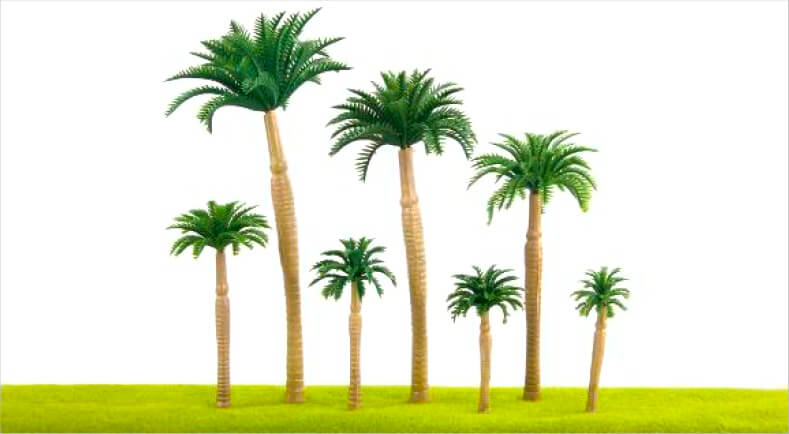
Florida Royal Palm (Roystonea regia)(image from internet)
The branchless upright trunk is stout and smooth.
The top part of the trunk near the leaves is green while other parts display a light tone of grey with a distinctive irregular bulge in the middle.
CHAPTER 4.5
Conclusion
Palm trees have been given different meanings throughout different stages in history and culture.
They symbolize the sun and victory, thus the Romans associated them with the worship towards Apollo, the god of the sun.
Since the 20th century, palm trees have become the representation of luxury and leisure.
They have been widely grown in gardens globally in many hotels, villas, gardens and even on the Titanic!
On that account, many wealthy landlords enjoy having palm trees planted in their courtyards.
CHAPTER 5:
How to choose the scale of architectural models
Model tree always is an indispensable element in scale models with various scales.
Model trees’ realism, naturalness, and aesthetic features all help the finished architectural models or master planning models become more flawless.
Nowadays, the scale range of architectural models is relatively wide; for example, the size of architectural interior models or facade models is usually within 1:100, while urban planning models and island models generally exceed 1:2000, and sometimes even reach 1:5000.
Under these circumstances, the scale of model trees, landscapes, miniature cars, and people should match the scale of the building model, otherwise a strong sense of violation will occur.

CHAPTER 5.1
Interior Architectural Model Trees (Scale in 1:5 – 1:25)
The interior model is most frequently used in marketing events or displayed in the real estate sales office to attract potential housing buyers and investors, as the viewers can understand what they are going to purchase once looking at the model.
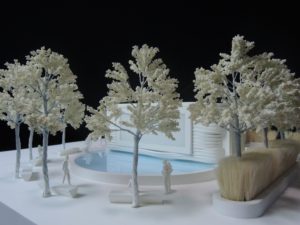
In order to present sufficient design details, 1:5-1:25 is a recommended model scale, and the model trees must follow this scale to manufacture.
Meanwhile, for the interior model, the model tree is no longer just a method to illustrate the outdoor plants, but also a technique to create the indoors potted plants.
Through the selection of model tree species and collocation of other interior accessories, like furniture, paintings and carpet, our model experts could help designers to effectively transmit the design concept and taste of life to the customers.
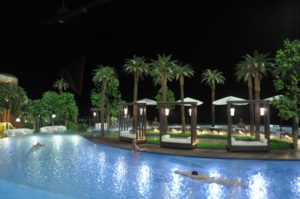
Club house model with model tree scale in 1:25
The final interior models usually coupled with the whole architectural model to depict the overall design and the covered roof is normally removeable; to consist with that, our model trees also dismountable to adapt different display requirements.
CHAPTER 5.2
Villa Scale Architectural Model Trees (Scale in 1:25 – 1:100)
Precisely show out the delicate house design is one of the fundamental functions of the villa model, a splendid villa model should also give a true sense of the living environment and the entire astonishing neighborhood to the potential buyers.
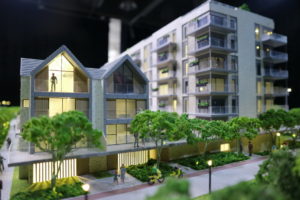
For most villa models, 1:25 to 1:100 scales are frequently used as with these scales, accurate exterior building forms and façade details can be presented, and so does the floor plans if necessary.
In the villa models made for subarctic or even colder regions, villas are customarily surrounded by snow fir model trees or cyber trees; while for projects in temperate regions, the models are dominated by various deciduous trees, like oak or elm.
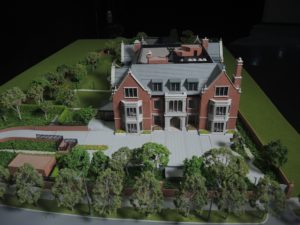
Villa model with model tree scale in 1:25
Since the trees live in the subarctic zone is usually taller and more gigantic than those in temperate, our model makers choose a slightly bigger size of sub-frigid model tree species to install in the model which also strengthens the contrast between housed and trees.
CHAPTER 5.3
Residential Building Model Trees (Scale in 1:50 – 1:300)
With more and more commercial residential buildings being developed and constructed, the market demand of excellent high-rise residential building model has increased significantly.
The substantial motivation is that the quality and sophistication of a residential model effects the customer's first impression of the overall real estate project.
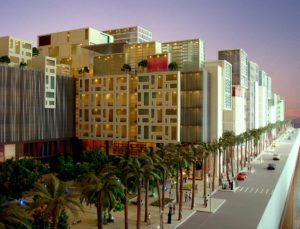
Under this size, the height of the model tree is usually between 3cm-10cm.
In order to balance the building design details and the overall layout of the project, the scale of the residential model is usually within the range of 1:50-1:300.
In the residential model, the layout methods of model trees are usually divided into two categories.
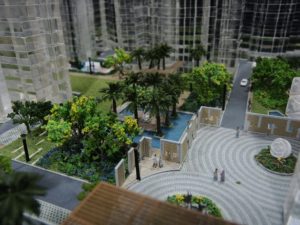
Residential buildings model with model tree scale in 1:100
One is to install along with the road and path, so that customers can understand the traffic system at a glance, and the other is to randomly scatter and create leisure space by the combination of model trees, shrubs and grass.
CHAPTER 5.4
Hotel Model Trees (Scale in 1:50 – 1:400)
From the perspective of the purpose of the itinerary, hotels are mainly divided into business hotels and resort hotels.
Business hotels usually concentrate in cities, and the more developed areas are, the denser they are; while resort hotels are generally located in places with beautiful natural scenery or places with a long cultural history.
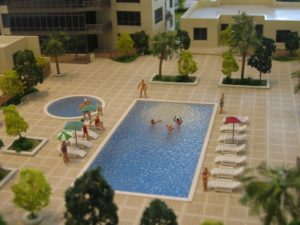
Hotel model with model tree scale in 1:100
Regardless of the type, the ratio of the hotel model is generally range from 1:50 to 1:200; if the hotel occupies a large area, the hotel model may reach a ratio of 1:400.
At the ratio of around 1:200, the height of model tree generally does not exceed 10cm, and the specific size depends on different species.
In the 1:100-1:200 hotel model, the model tree is not only used to express the surrounding natural environment, but also to portray the artistry in the hotel; for example, in some boutique hotels, the designer will design the courtyard in the style of Japanese Wabi-Sabi, where a same scale curly pine model tree is essential.
CHAPTER 5.5
Shopping Mall Model Tree (Scale in 1:100 – 1:400)
The shopping mall model, usually being a part of a complex of offices and residential apartments model.
The surroundings of the mall, including residential zone, green belt, traffic condition, and available facilities around the area, are also important factors to be added to reveal the commercial value of the shopping mall.
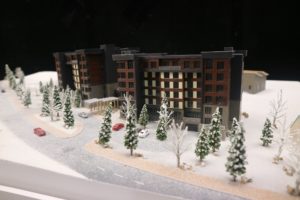
Shopping mall model with model tree scale in 1:100
Therefore, architects often design the most appealing outdoor landscapes to attract the public, which makes the model trees and plants significant in presenting a modern shopping mall model.
Under the scale of 1:100, using the model trees to decorate the indoor pedestrian street or vertical green walls will add a lot of vitality to the shopping mall which gives the customers more attraction.
Occasionally, the designer sets giant trees and fountains in the middle of the atrium to impress customers, and our model makers will choose a relatively bigger size model tree comparing with the whole model to highlight the unique design.
CHAPTER 5.6
Landscape Model Tree (Scale in 1:100 – 1:5000)
The landscape model incorporates various scenery elements like vegetation, water features, and other hard landscaping such as different kinds of soil, rocks, etc., and specific topography and landforms.
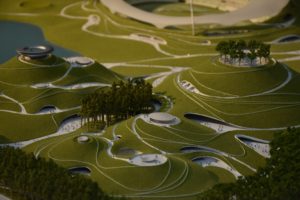
As a representative work of the natural products, landscape models capture the essence and the natural feeling of the sites.
If the landscape model is created for some residential projects, then the scale will be around 1:100- 1:5000; if it is a single landscape project, the scale will be increased, considering it normally has a large occupied area.
The model tree species and sizes are abundant in a landscape model; however, they always maintain the same ratio with the whole model (around 1:5000).
Sometimes, it is necessary to highlight a certain tree or part of the plants in the model, then the ratio of them will basically fluctuate up and down the model scale to keep the harmony.

Island model with model tree scale in 1:100
CHAPTER 5.7
City Planning Model (Scale in 1:500 – 1:2000)
Master plan models are adopted by the designers to present a future scene of a certain area to the government and public.
To show the planning area on an appropriate scale, our model experts usually choose to make the masterplan model in a ratio of 1:500 to 1:2000.
Model trees under the scale of 1:500 is very tiny and usually shorter than 3cm; if under 1:2000, it will be even smaller than a thumbnail.
The addition of model trees in a city planning model transmits the awareness of nature during the development of modern cities.
Install the great numbers of tiny model trees in the model is a time-consuming task, but our model tree experts can still complete the mission flawlessly every time.
CHAPTER 5.8
Railroad Model Tree (Scale in 1:24-100)
The railroad models customarily include locomotives, rolling stock, streetcars, tracks, signaling, and landscapes that include countryside, roads, bridges, buildings, vehicles, urban landscape, model figures, lights, and features such as rivers, hills, tunnels, and canyons.
The scale of the railroad model depends on the gauge between the rails other than the popular scale, like 1:50 or 1:100, and the most popular railroad scales are Gauge 1, G scale, O scale, S scale, HO scale, TT scale, and N scale.
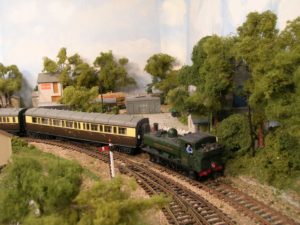
Railroad model with model tree scale in 1:100
Among them, the G scale (1:24) is the most popular for backyard modeling in history, which is easier to fit into a garden and keep scenery proportional to the trains.
Nowadays, the railroad model has kept the tradition and frequently made in the scale of 1:24-1:48.
Because of the abnormal scale, our model experts have specially made a set of model trees with the size from 1:24 to 1:48 to fit the railroad model.
CHAPTER 5.9
Conclusion
The scale of the architectural model ranges from 1:1 to 1:5000, as a significant decoration, the scale of the model tree naturally needs to be wide enough to meet the requirements of different scales.
Generally speaking, the finer the model tree, the longer it takes to make one, but its quantity required in a model is often limited; conversely, the model tree with a large quantity demand generally has a lower level of detail requirements.
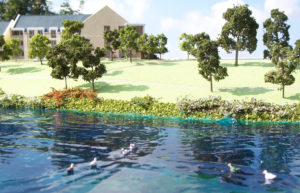
The architectural model tree plays a role as a significant decoration.
Our model tree makers not only use traditional methods -- twisted wires and scattered materials, to make model trees but also constantly innovating, such as using 3D printing technology to make pure white model trees in specific models and fulfill the requirements of clients.
CHAPTER 6:
Different style of scale model trees
The architectural model tree plays a significant role in numerous kinds of models.
Scaled model trees not only enhance scene realism, embellish landscapes and architectures, provide visual references, but also present the aesthetic and taste of the design team.
Since the purpose of architectural and masterplan models are frequently distinguished, the model trees accommodated to them have to be created according to specific needs.
White architectural model trees, wooden architectural model trees, realistic style architectural model trees, colored architectural model trees, and snow architectural model trees are five types that commonly selected in models.
TL Models have superb model tree making teams to handcraft any sort of model trees and satisfy the dissimilar needs of models.

CHAPTER 6.1
White architectural model tree
The white model tree is frequently adopted in white architectural models which generally used to show the basic volume and layout of a project.
This type of model tree integrates into the overall model superbly, maintaining the minimalism tone of the whole white architectural model.
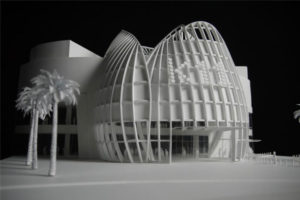
Examples of white architectural model tree
Because of the lack of color change, our model tree makers pay more attention to the fundamental shape of the trunks which are twisted by white iron wire in most cases.
As usual, model tree experts do research about the local climate and landscape in the first place, then considering the given time and material, selecting several most appropriate tree types to handcraft.
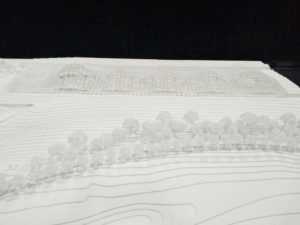
Examples of white architectural model trees
Since the unique genre of the white architectural model, scale people and cars sometimes are dismissed or omitted in the model to show a neat scene, therefore the white model trees take the role as a reference for viewers to understand the size of buildings at the first glance.
CHAPTER 6.2
Wooden architectural model tree
The wooden model tree is another distinctive model tree classification which has become gradually popular in recent years.
A superior architectural model should not only show the design flawlessly but also fit the designers' style; famous architects usually have their iconic material system, like Kengo Kuma, who use the wooden material in his design excellently.
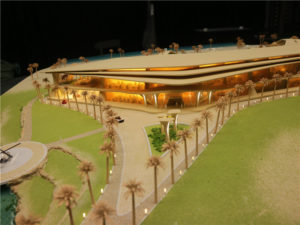
Example of wooden architectural model tree
In those wooden architectural models, whether white model trees or realistic model trees would not be as ideal as the wooden model trees that blend into model consummately.
The wooden trees are frequently used in the museum model, landscape model, city planning model, and other wooden made models.
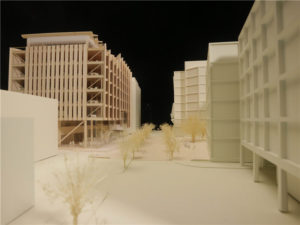
Example of wooden architectural model tree
Our model experts take advantage of advanced techniques to create various sorts of wooden trees, except for the commonly used wooden foam/sponge, they also use thin timbers to outline trees.
Wooden made the model always transit a warm and natural feeling with the value of ecological, which also implies that TL Models take social responsibility into consideration in our product.
CHAPTER 6.3
Realistic architectural tree model
The realistic model tree, because of its authenticity, is an excellent way to bring reality and professionalism to the scale models, therefore it has become one of the commonly used model trees in architectural models.
Considering the different size and distinguished emphasis in every model, our model tree makers tailor the scaled tree-style according to the adjusted needs.
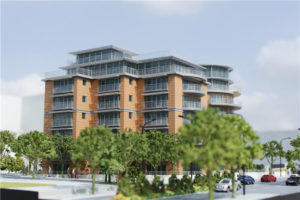
Example of realistic architectural model tree
In big-scale models, for example, the master planning model, island model, and landscape model, the model tree is small in every single size but big in the total number needed in the whole model; therefore, our model tree experts usually adopt a pipelined division of labor and cooperation to produce the tree needed in this sort of model.
Model experts first use iron wire or bendable plastic to make the tree trunk, then spray the appropriate foliage sponge on trees with adhesives, and plant finished trees along the roads or buildings; if there are special topographies in the models, like hills and canyons, model trees will be scattered planted clustery following the natural law.
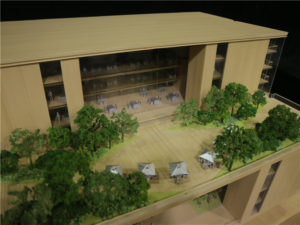
Example of realistic architectural model tree
In medium-scale models, such as the airport model, city model, and residential model, each single model tree should be relatively larger and present more detail. Comparing with the hundreds, even thousands of model trees needed in the big-scale model, the amount in medium models will be small, which gives our model makers availability to concentrate on details and characteristics.
With diverse budget and investment, the targeted customers of each project are different; to precisely show out each project’s marketing positioning in the models, except for the differences in architectural buildings, the model tree also plays a significant role.
Pine, willow, poplar, and cypress are easy to be seen in the public building projects, whereas the costly ginkgo, podocarps, phoebe, and fraxinus can only be seen in the high-end residential projects.
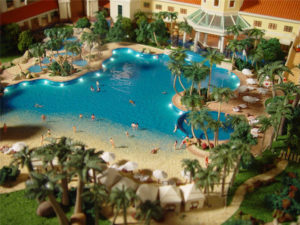
Example of realistic architectural model tree
In the small-scale models, such as the villa model, school model, shopping mall model, and even façade model, the number of model trees is limited because of the scale, and the requests of the scaled tree model are concentrating on details and authenticity.
In this circumstance, the model tree is not only a decoration for the model, but also gives a reference to the viewers and evokes the variety of nature and imparts softness and realism to architectural models.
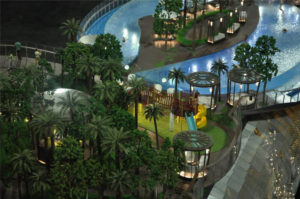
Example of realistic architectural model tree
TL Models has been constructing scale model trees since 2005 and the realistic model tree is one of the collections that our model experts have accumulated most experiences over the past years.
Copper wire, steel wool, scraps of sponge, strips of metal, and foam are our model specialists' most widely used materials during the realistic model tree making process, sometimes, the 3D printer is also adopted for special shape.
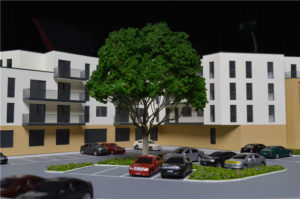
Example of realistic architectural model tree
Our tree model making team has formulated a mature mode for realistic landscape—bushes and shrubs are used to present lower planting, grass roll is used to cover the base, assorted flowers is used to sprinkle on bushes and vines to create flowering plants, and then plant the distinguished handmade model trees in the model according to the design.
CHAPTER 6.4
Colored architectural model tree
The architectural model is static, while our life has seasons' change, therefore, colored trees and other landscape embellishments are used to decorate the model and show out transforming seasons.
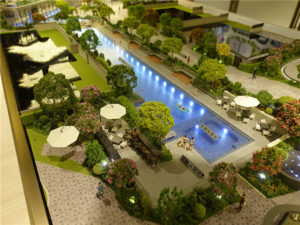
Example of realistic architectural model tree
Besides, in different continents and regions, the vegetation is distinct and has its special color; people are usually sensible to colors, a suitable plant color can tell more information to viewers then our imagine.
In the residential projects, the richness of the landscape sometimes indicates the marketing positioning of a project; more high-end the project, more variety vegetations are commonly needed.
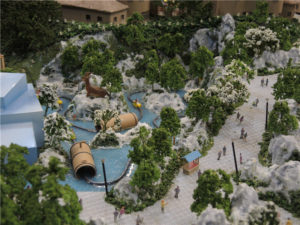
Example of realistic architectural model tree
For architectures that have strong cultural characteristics and local color, lick the buildings in the middle east area, the selection of model tree color must be suitable for the main color tone.
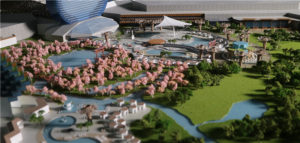
Example of realistic architectural model tree
With the accumulation of experiences in tree making, the model tree color is able to be blended meticulously by our model experts, even a simple green can have distinct elegances with different saturation.
CHAPTER 6.5
Snow architectural model tree
When making model trees for the project in the cold belt area, our model makers usually randomly scatter lots of artificial snow powder on the tree models.
Artificial snow powder is made of a super absorbent polymer that mimics the snow vividly even in normal indoor temperature.
Pine, cypress, spruce, and fir are several symbolic trees in the frigid boreal forest, therefore, our model makers put emphasis on making these species and match them with architecture under the dissimilar requests of each project.
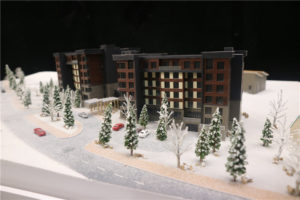
Example of snow architectural model tree
To display the city scene in cold areas realistically, our model experts install the snow model trees and also spread the snow powder upon the land and architectures.
With the faith of creating the best model in mind, our model makers supplement another step during producing the snow model trees, they dip some leaves in glue, so the snow powder can be attached on the tree steady and help the model maintains in best status.
CHAPTER 6.6
Conclusion
We have a long history of model making since 2005, along with which we have accumulated abundant experiences in distinguished projects.
TL Models has separate product lines and model teams for different types of models and supplements to meet any requests from our clients.
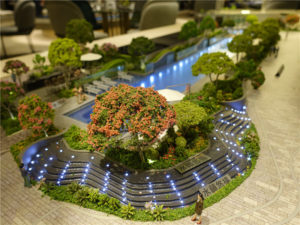
Example of architectural model trees
During the model making process, our model experts always keep close contact with the design team and guarantee the final model trees meets the expectation and requirements.
We have cooperated with many world-famous architectural design firms in lots of landmark projects, they often have a deep impression of our efficiency, expertise, and professionalism in model making, which induce more cooperation.
Top-quality and excellent service are our two key strengths, we provide global shipping with the professional package to assure the status of exquisite models, and we also have specific service team to fulfill your 24*7 needs across continents.




